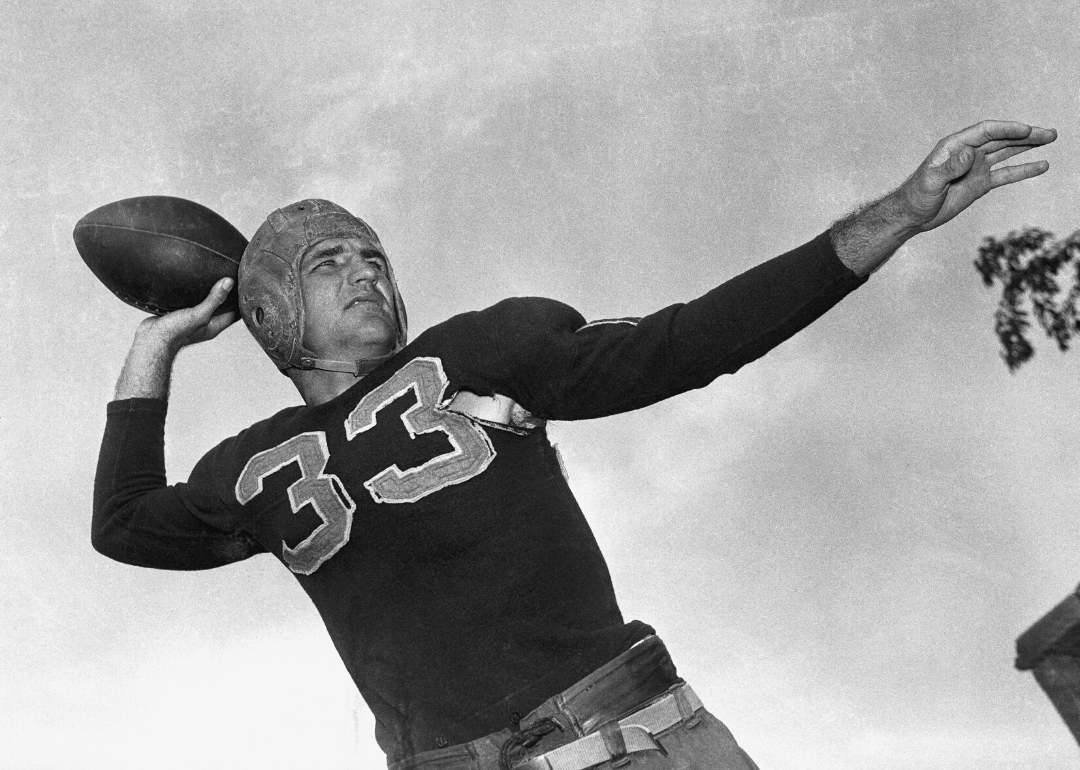
Iconic jerseys of the NFL then and now
NFL jerseys are badges of honor among fans, who proudly rock their teams' colors every Sunday (or Monday and Thursday). Topping the NFL's jersey sales list is akin to climbing atop the Billboard charts with a hit single, a signifier of popularity for the game's top players. These charts also indicate when fan bases are hungry for a rebirth, as team's usually see an uptick in sales after a jersey redesign or drafting of a highly touted college player. While it used to be a scavenger hunt to find jerseys on sale, you can now purchase one for almost any player on a team in a variety of colors—and even personalize it with your own name.
To celebrate the NFL's rich history of style, Stacker compiled a collection of iconic jerseys past and present for each NFL team, using photos from Getty Images. We used a variety of primary news sources, team websites, the Pro Football Hall of Fame, and databases that specifically track jersey history to come up with 64 slides that include all the colors of the rainbow and then some. The photos in the slideshow not only provide a trip down memory lane, but also the evolution of teams and vital chapters in their histories.
For example, the Tampa Bay Buccaneers definitely stood out in their orange-creamsicle jerseys, but for fans of the Bucs, the threads also signify losing—and a lot of it. The Bucs lost their first 26 games in the NFL. Often, a new team jersey means a new stage, whether that be of a legendary player moving on, a franchise-saving quarterback arriving, or just a wish to relive past glory days. The Atlanta Falcons, Cleveland Browns, Los Angeles Chargers, Los Angeles Rams, New England Patriots, and Buccaneers all introduced new jerseys this offseason, showing that there's much more history to be written. Find out how your team has changed (or hasn't) over their NFL tenures.
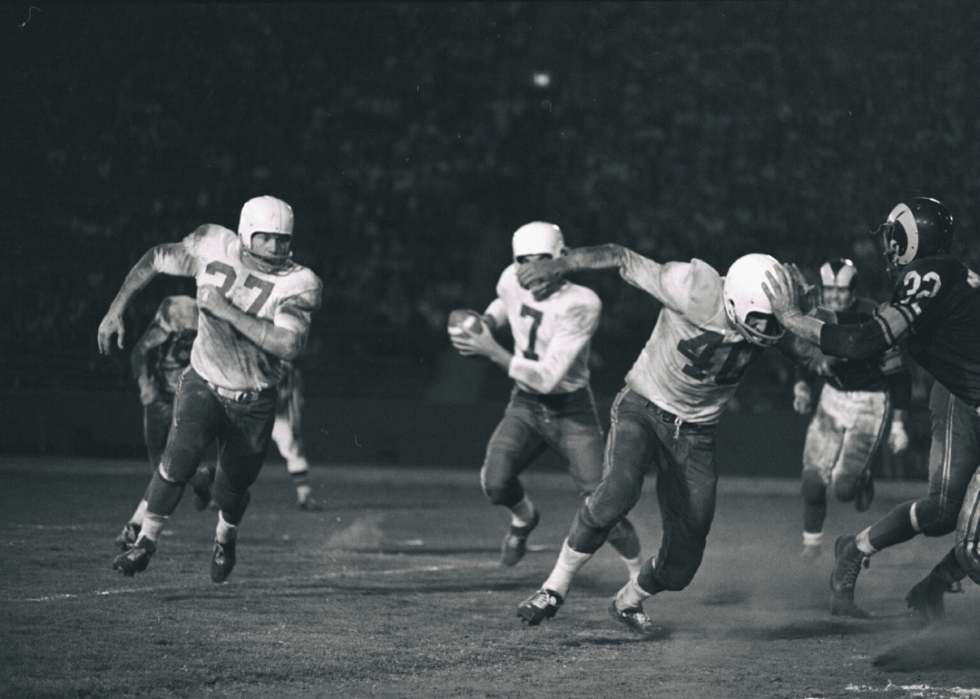
Then: Arizona Cardinals
When the Cardinals played in Chicago, their jerseys were pretty straightforward. Basic whites with cardinal-red numbers were the standard, except for the occasional mud or grass stain. While wearing this version, Bobby Joe Conrad led the league with 73 receptions in 1963.
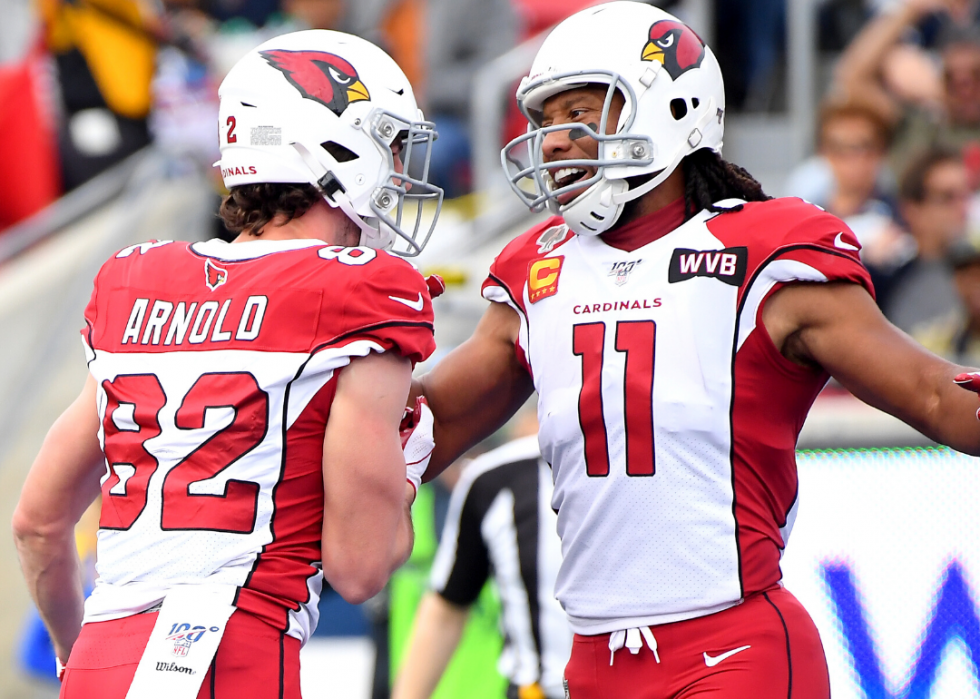
Now: Arizona Cardinals
In the mid-2000s, the Cardinals switched to a more modern jersey layout, with contrasting colors on the shoulders and side panels. This look has become synonymous with Larry Fitzgerald, who in 16 years in the desert has reeled in 1,378 receptions and made 11 Pro Bowls.
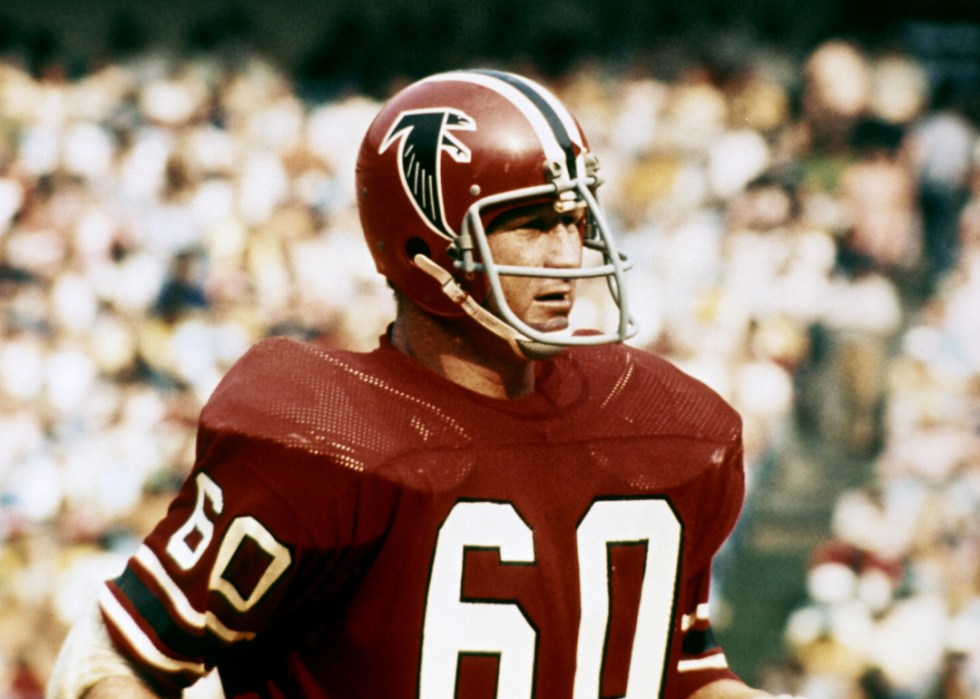
Then: Atlanta Falcons
The Falcons’ red jerseys did not symbolize too much glory on the field, but they still represent a certain nostalgia for Atlanta football fans who grew up with Bob Berry at quarterback. The Falcons entered the league in 1966 in black duds but switched to red for the 1970s.
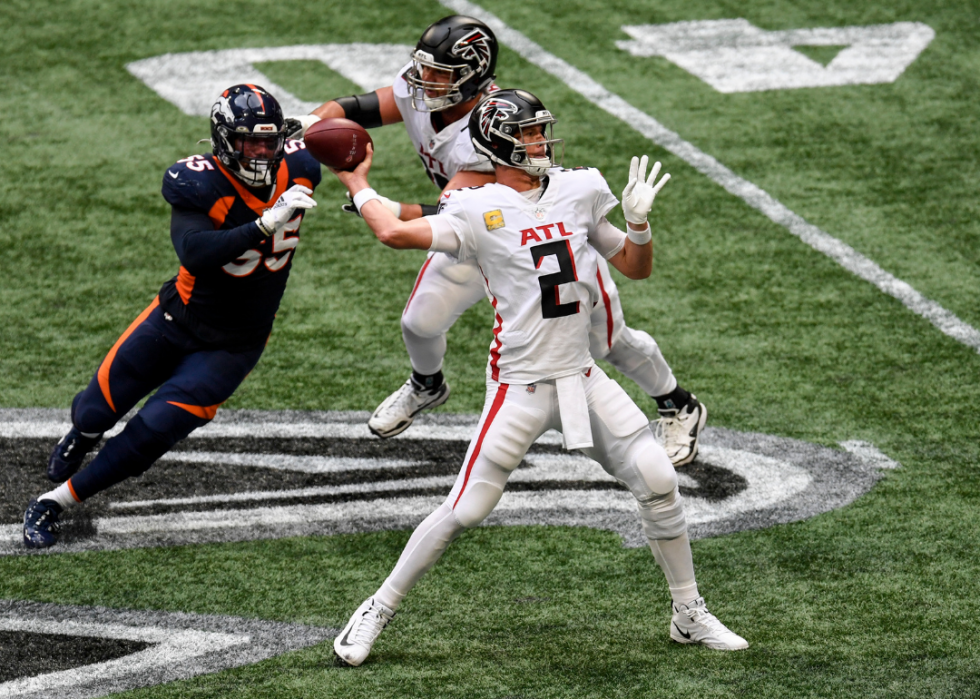
Now: Atlanta Falcons
When the Falcons revealed their new jerseys in April 2020, the major theme was “back to black.” For years, the Falcons wore red jerseys at home, but the new black uniforms harken back to the days when Deion Sanders shut down receivers regularly at the Georgia Dome, as well as when the "Dirty Birds" made the Super Bowl.
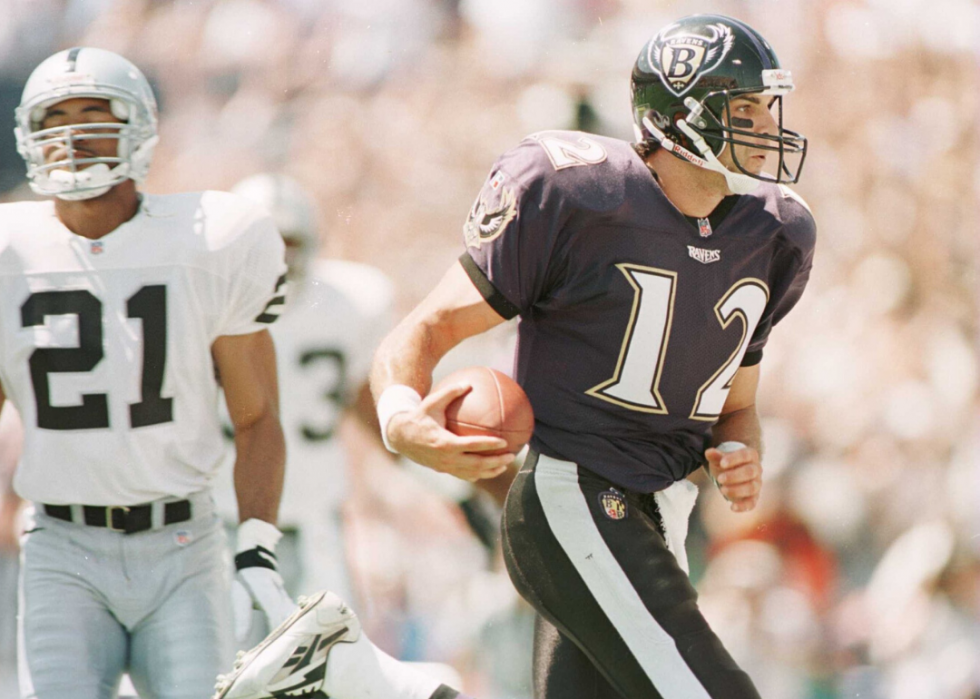
Then: Baltimore Ravens
A notable difference in the Ravens' original jerseys is the size of the numbers. In addition, a winged Raven patch on the sleeves made this look unique—and one of seven jerseys worn by Vinny Testaverde.
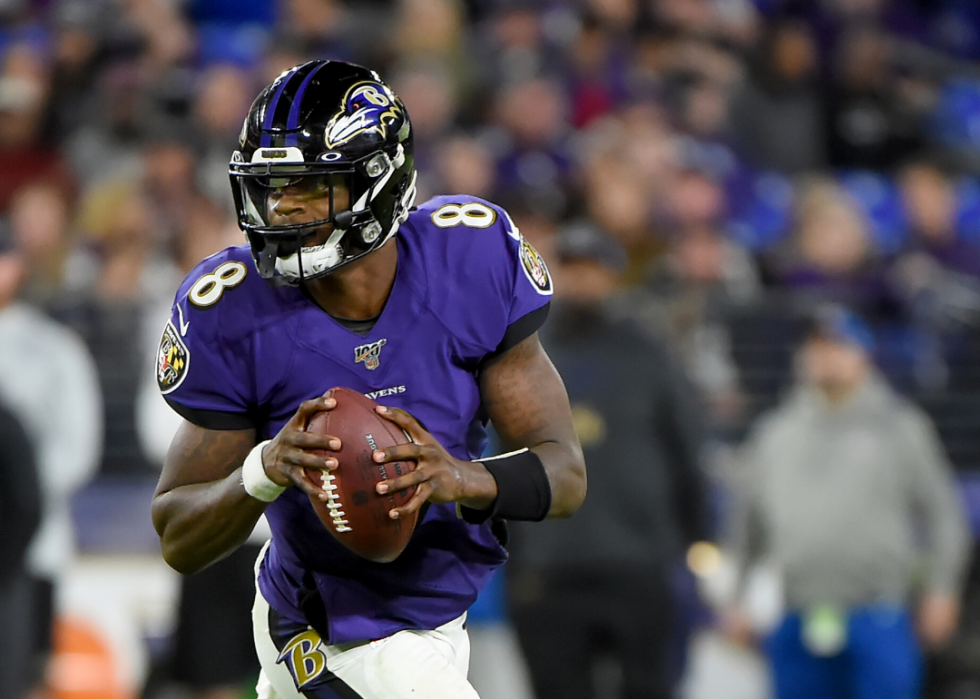
Now: Baltimore Ravens
The Ravens’ jersey has not changed much since the team's inception in 1996, except for smaller numbers and a different crest patch on the sleeves. The helmet has undergone redesigns, but the dominant purple, white, or black jerseys without many stripes or accoutrement are staples. In an interesting twist, some Ravens have had special pockets sewn into their jerseys at times.
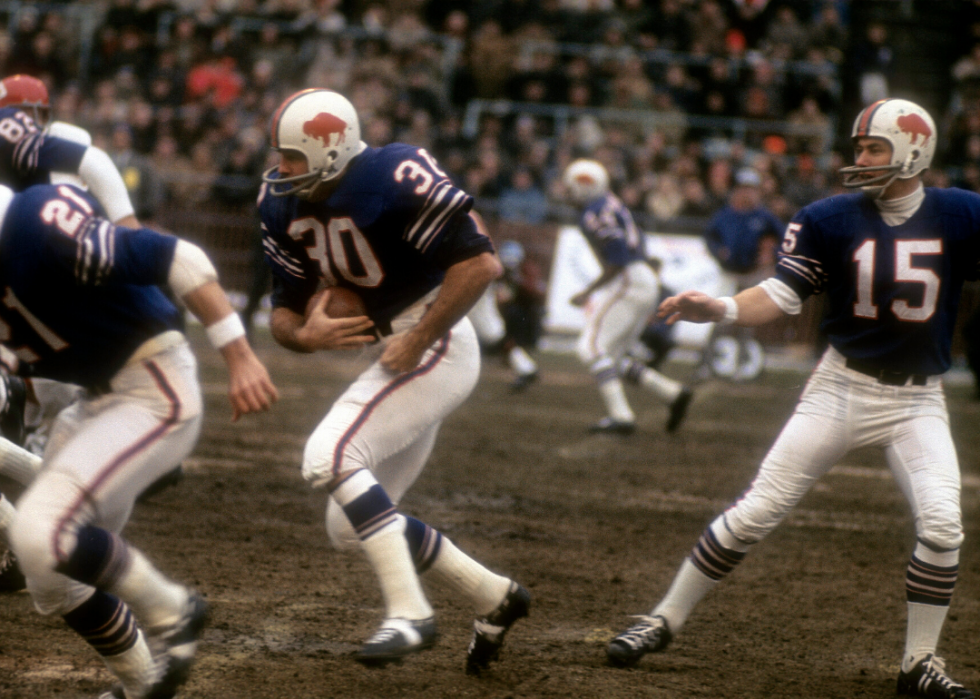
Then: Buffalo Bills
The Bills jerseys worn by Jack Kemp (the former congressman) were simple yet effective. Blue with white and red stripes, they gave the team a classic look, one the team would wear in the years to come.
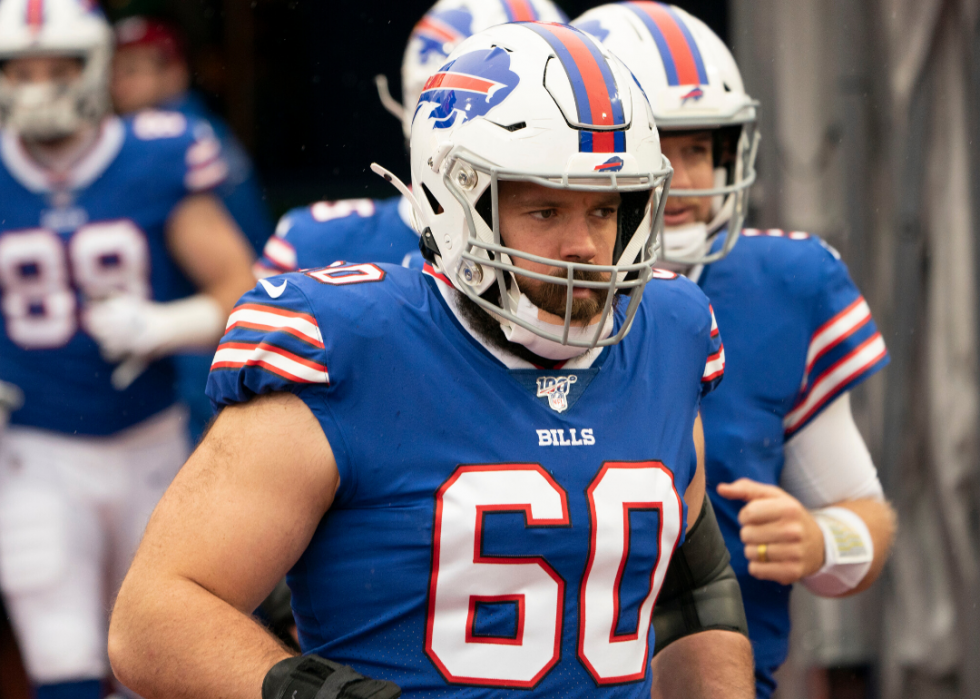
Now: Buffalo Bills
The Bills made a big change at the turn of the century, ditching navy blue and going back to their blue, red, and white roots. The current set isn't that different from the 1990s glory days which featured Jim Kelly, Bruce Smith, and Thurman Thomas, with the most noticeable difference coming in the team's use of white helmets again over red.
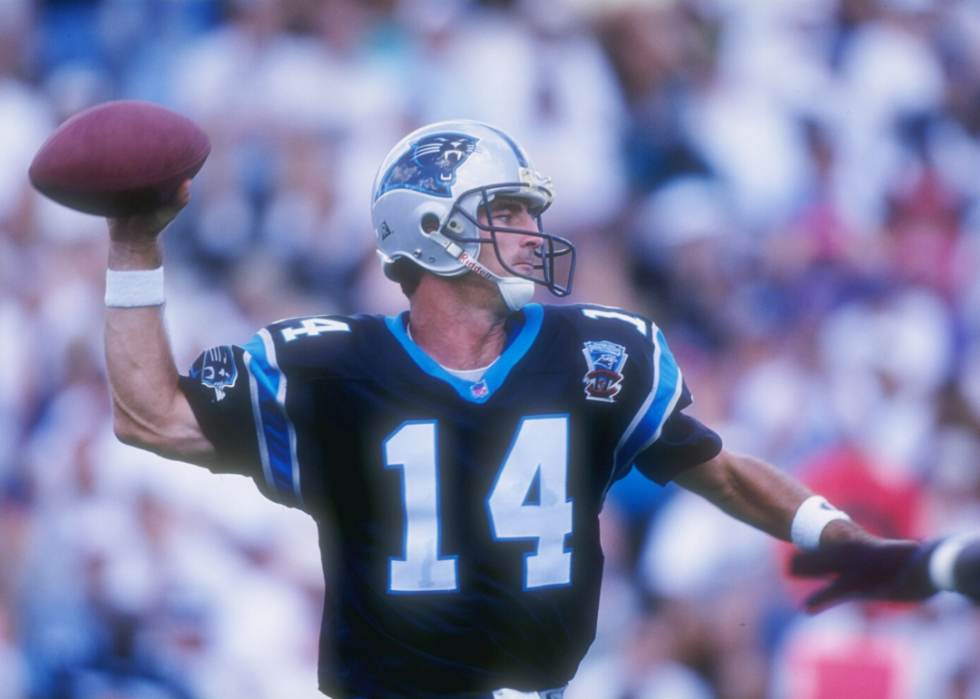
Then: Carolina Panthers
Many jerseys in the 1990s sported huge numbers on the front, a style which has been toned down since. This classic look with blue and silver stripes remains today. Frank Reich, who started the first game in Panthers history, now coaches the Indianapolis Colts.
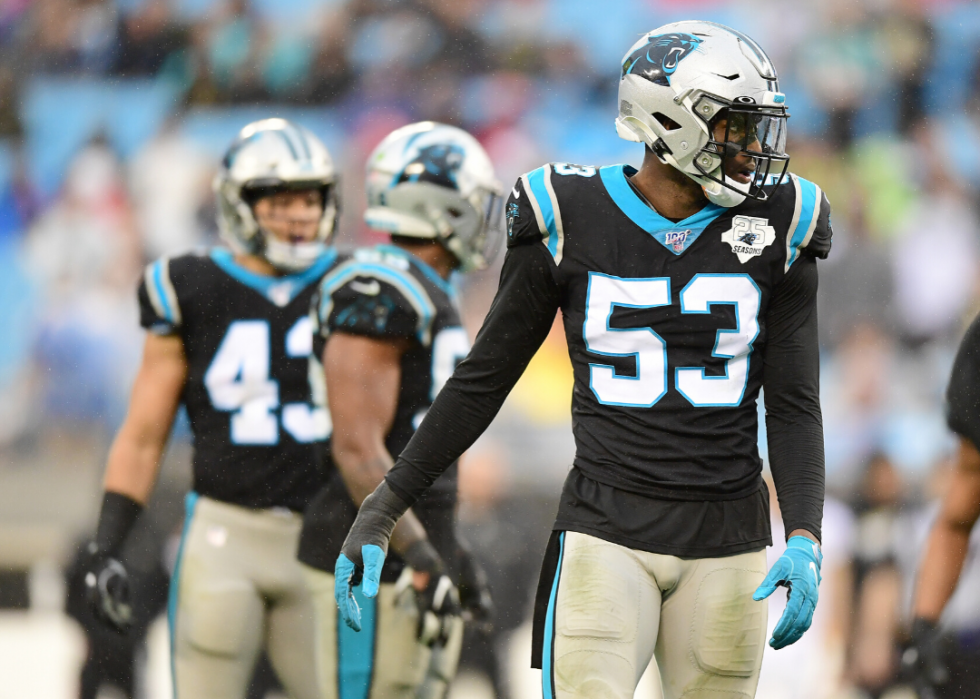
Now: Carolina Panthers
The Panthers' uniforms haven't really changed since their inaugural season in 1995. Aside from different sock combos and mixing-and-matching pants sets (and the lack of commemorative patches), the team has retained the same style for 25 years. Recently, under Cam Newton, the Panthers have often worn an all-black uniform at home, but Newton was released by Carolina in March 2020. He signed a deal with the New England Patriots in July 2020.
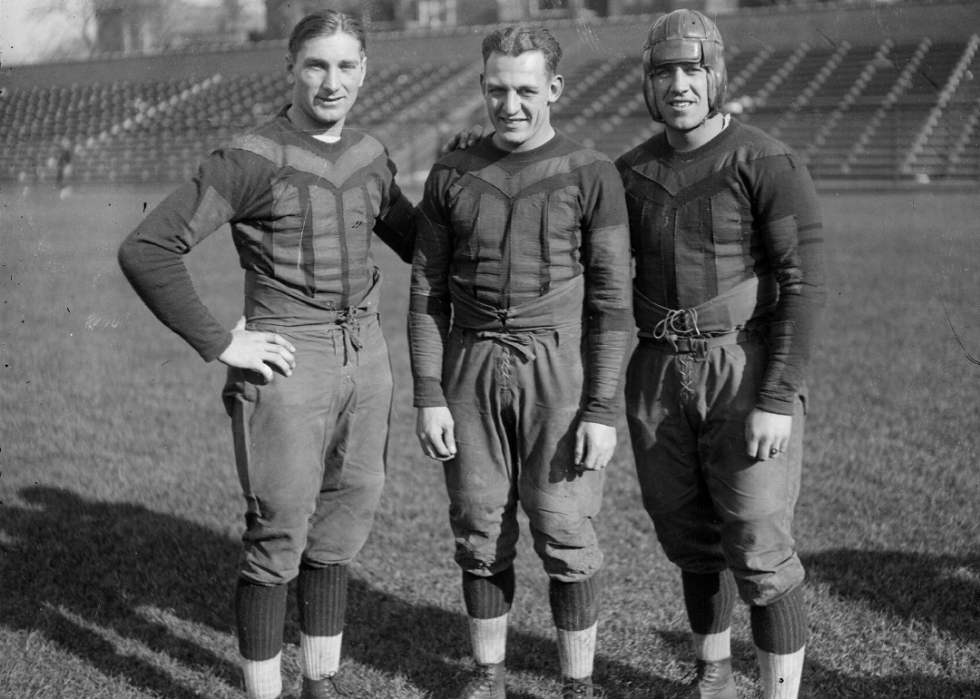
Then: Chicago Bears
The vintage Bears uniforms didn’t really resemble modern football jerseys at all. Still, Red Grange, nicknamed “The Galloping Ghost,” ran his way all the way to the Hall of Fame in leather and long sleeves.
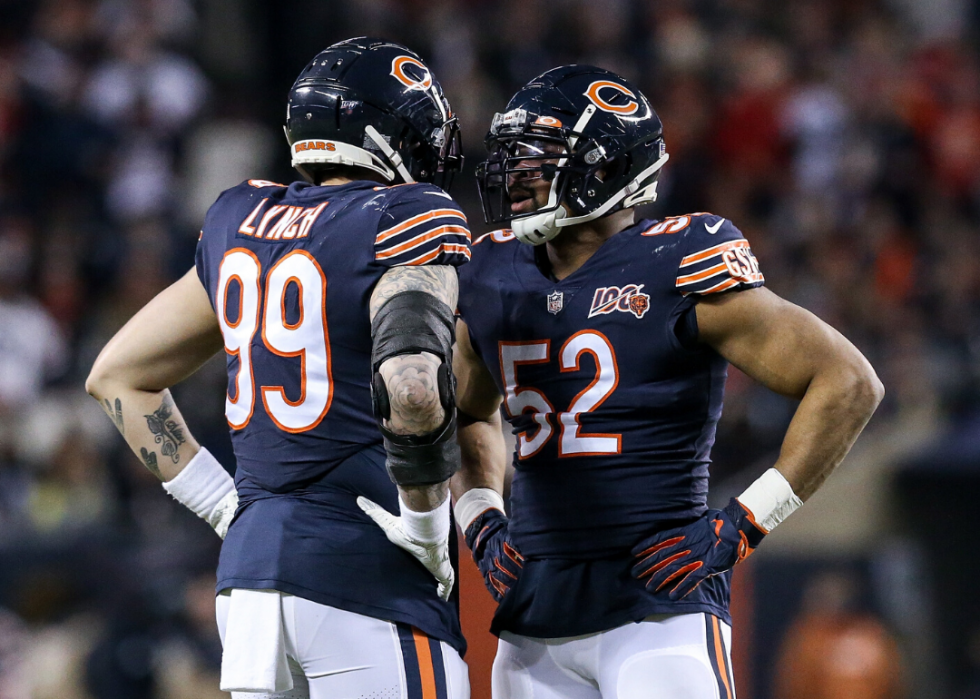
Now: Chicago Bears
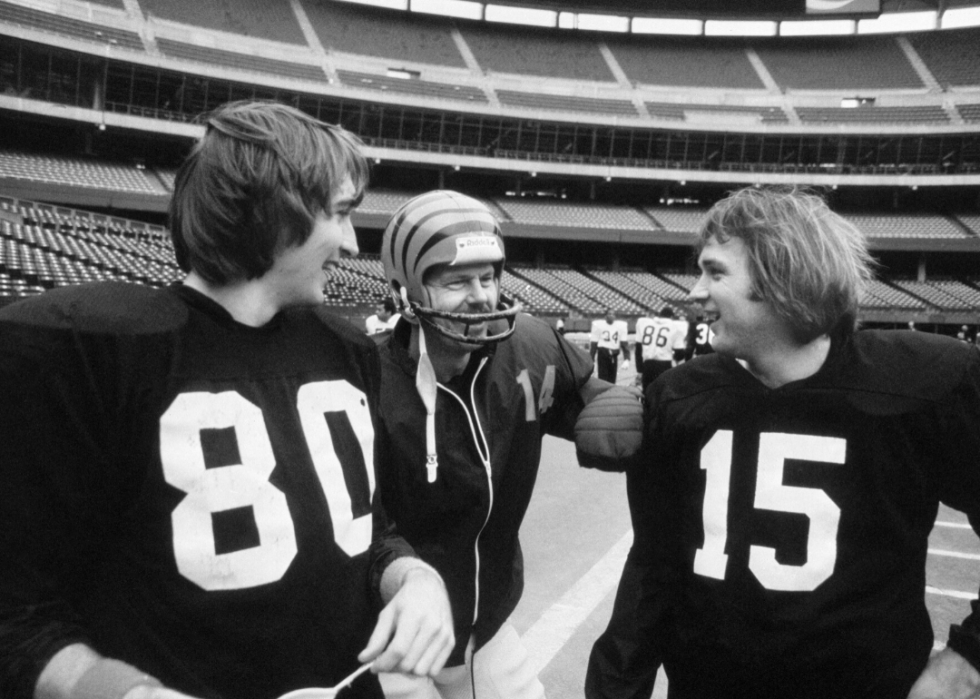
Then: Cincinnati Bengals
Cris Collinsworth is now the lively voice of NBC’s Sunday Night Football, but the jerseys he wore with the Bengals were pretty bland. Black with white numbers, they lacked the bengal stripes that have now become a trademark of Cincinnati football.
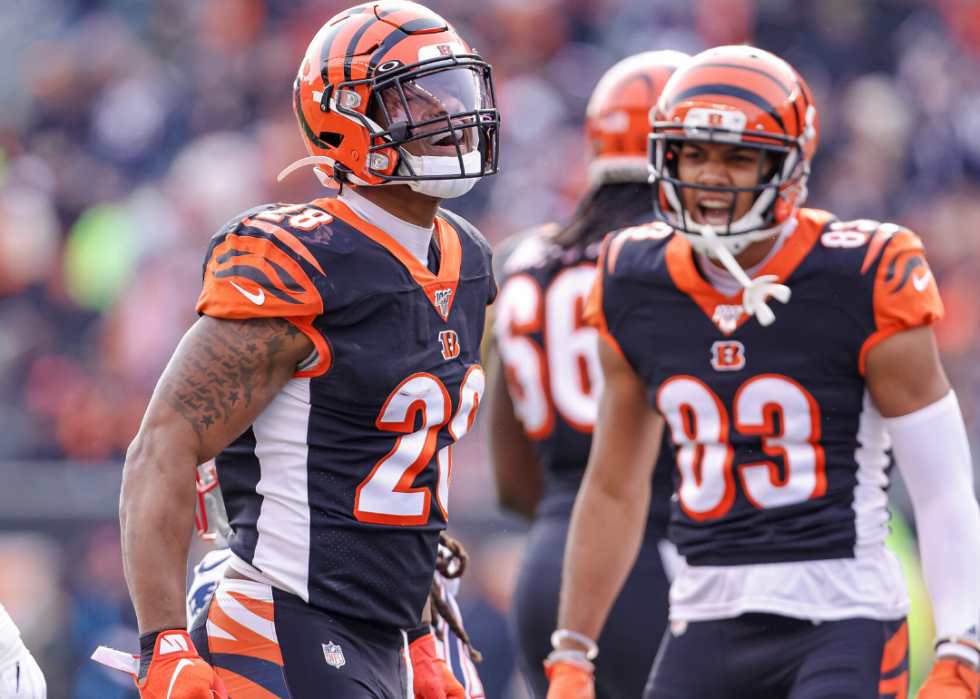
Now: Cincinnati Bengals
In the early 2000s, the Bengals began adding more flair to their jerseys, which not everyone agrees is a good thing. The white side panels, striped sleeves, and black body make Cincinnati's jersey one of the more active designs, and it was worn by Chad Ochocinco and Andy Dalton. With first overall pick Joe Burrow now in Cincy, the team could look for a new design to signal a new era.
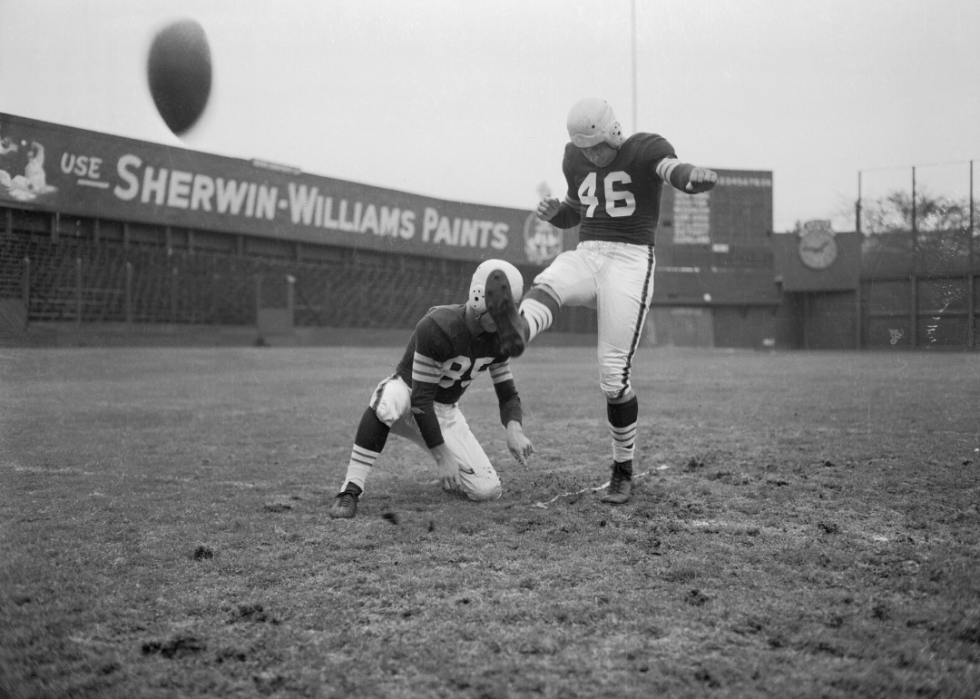
Then: Cleveland Browns
For most of the Browns' history, the team has kept their uniform designs pretty simple. Without an actual mascot, there's no need for patches—just the color brown. The award for college football's best kicker is named after legendary Browns kicker Lou Groza.
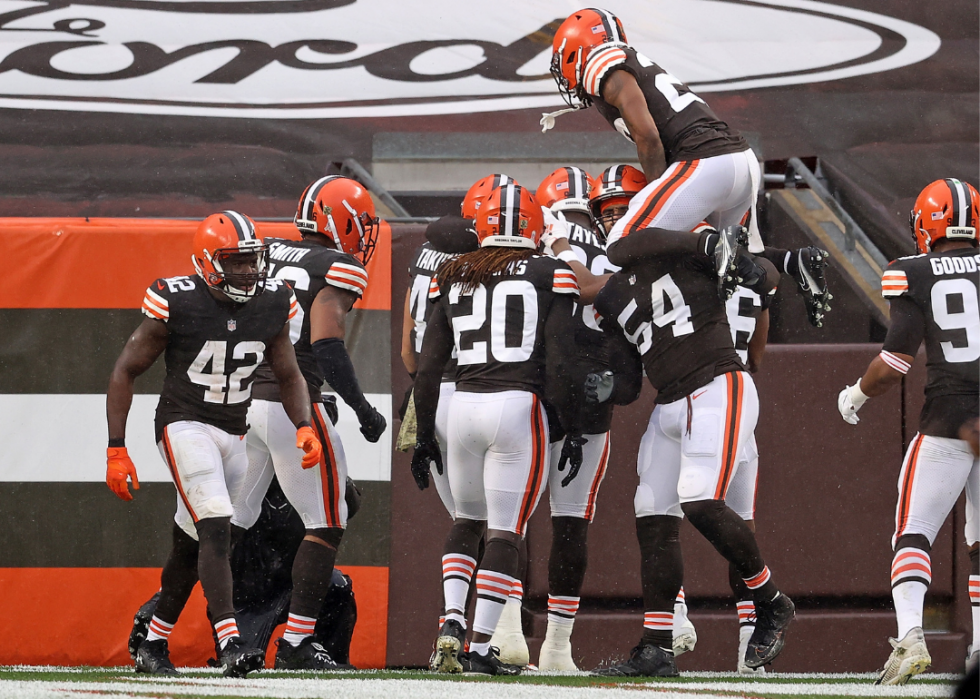
Now: Cleveland Browns
In April 2020, the Browns revealed new uniforms that update a 2015 redesign, removing the more modern elements in favor of the old-school simplicity of its older jersey. The word "Cleveland" has been removed from the chest, and the simpler look is meant to evoke the days of Jim Brown and other Cleveland gridiron legends. The team is the only one in the NFL to play with no logos on their helmets.
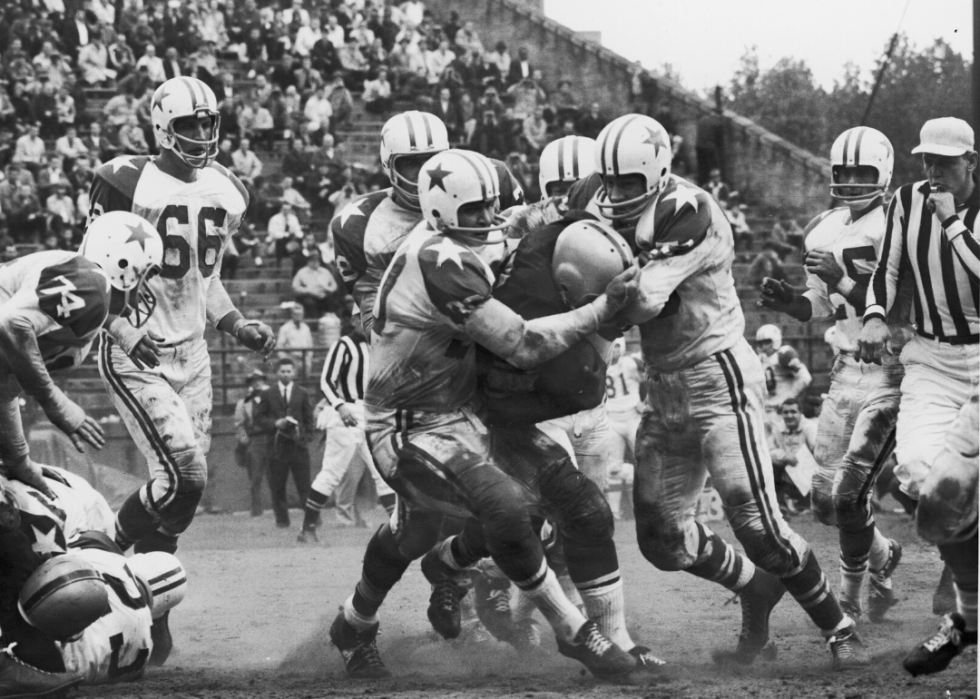
Then: Dallas Cowboys
The Dallas Cowboys have never featured an actual cowboy on their jerseys, but shades of blue and white, and a large star, have been ingredients. The star is supposed to signify “The Lone Star State,” the nickname of Texas.
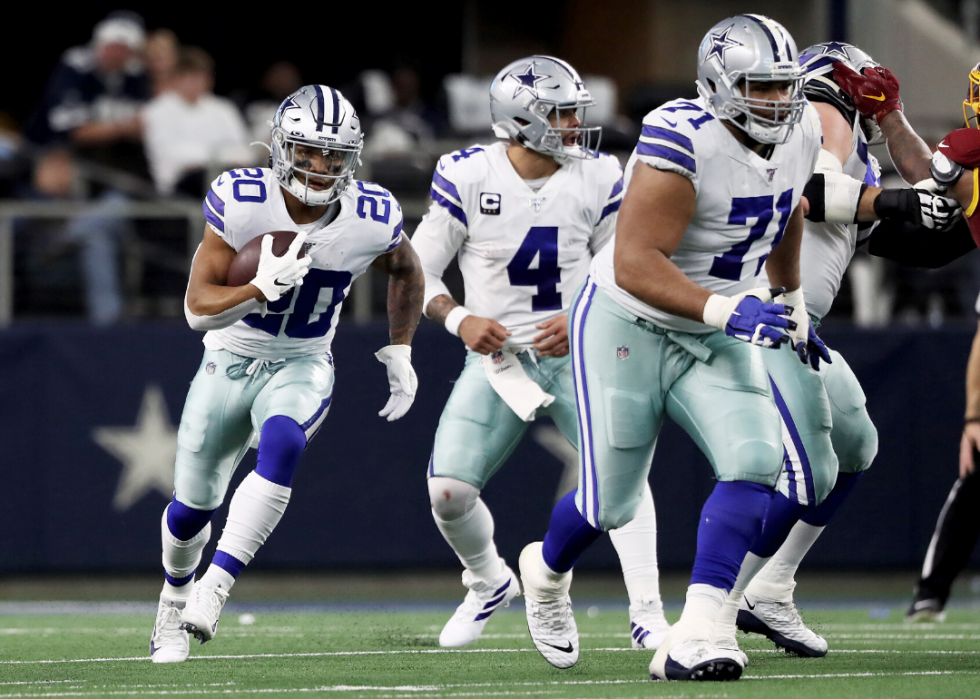
Now: Dallas Cowboys
Love 'em or hate 'em, it's hard to deny that the Cowboys’ jersey is one of the most recognized in the NFL. The simple striped-sleeve look hasn't changed since the late 1960s, except for a brief detour in 1995 during the NFL's 75th season, which harkened back to the star shoulder design.
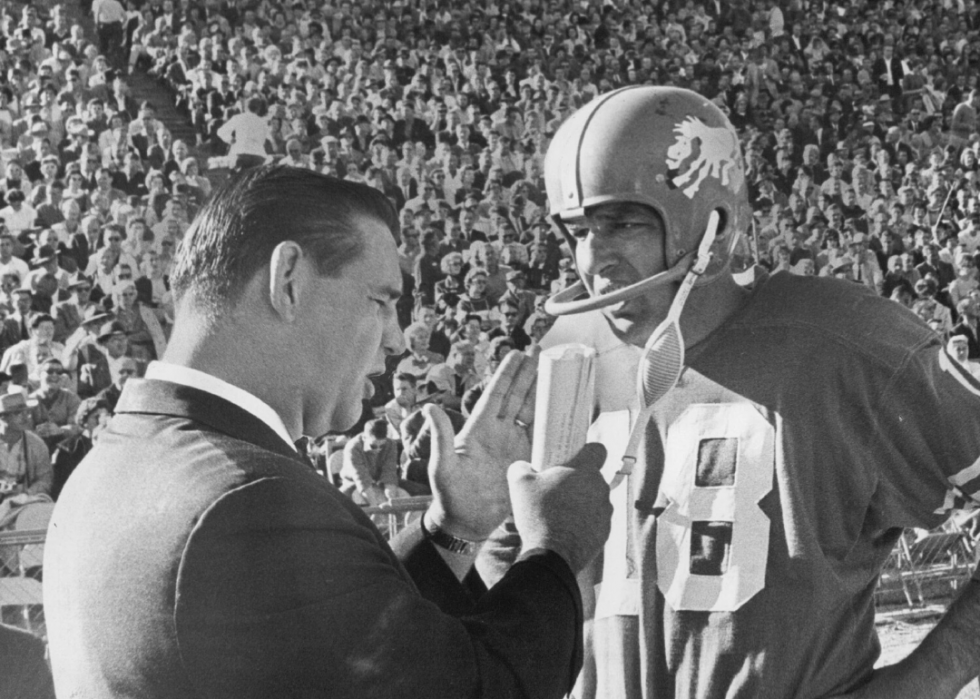
Then: Denver Broncos
The vintage Broncos jerseys were yellow and brown, but the team quickly switched to orange as the main color, which is seen here. Quarterback Frank Tripucka was out of the league for eight years but returned in 1960 to lead the Broncos for four seasons, even making a Pro Bowl in 1962.
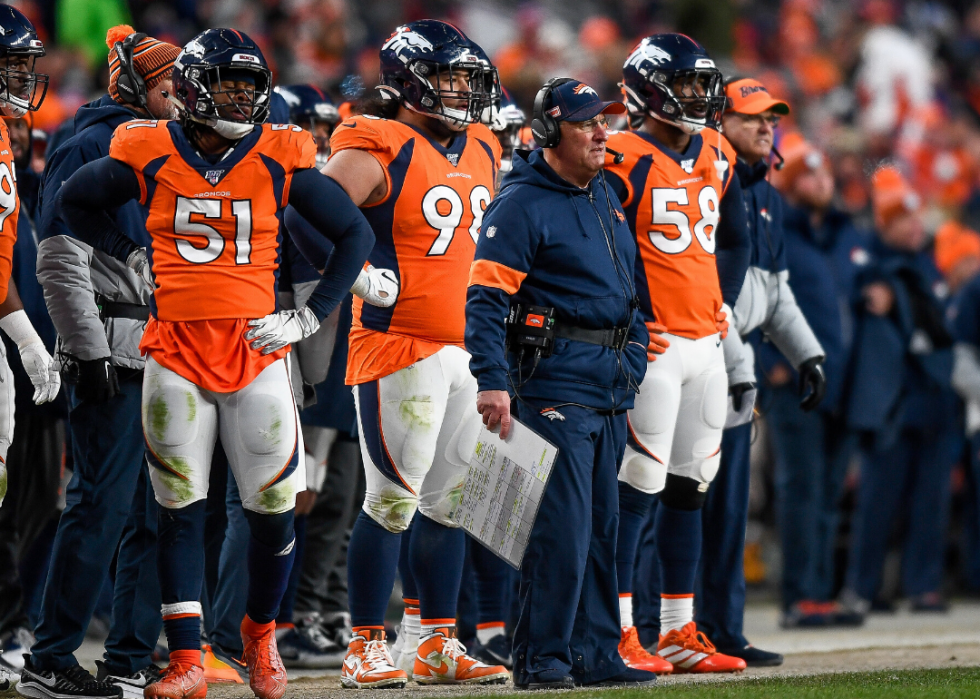
Now: Denver Broncos
Since 1997, Broncos jerseys have had the same layout, with fang-like stripes running up the sides. The franchise won their first championships in these uniforms when John Elway and Terrell Davis led Denver to wins in Super Bowls XXXII and XXXIII. Later, Peyton Manning preferred wearing the orange variation of the jersey at home, which has remained the standard worn by Denver at Empower Field at Mile High.
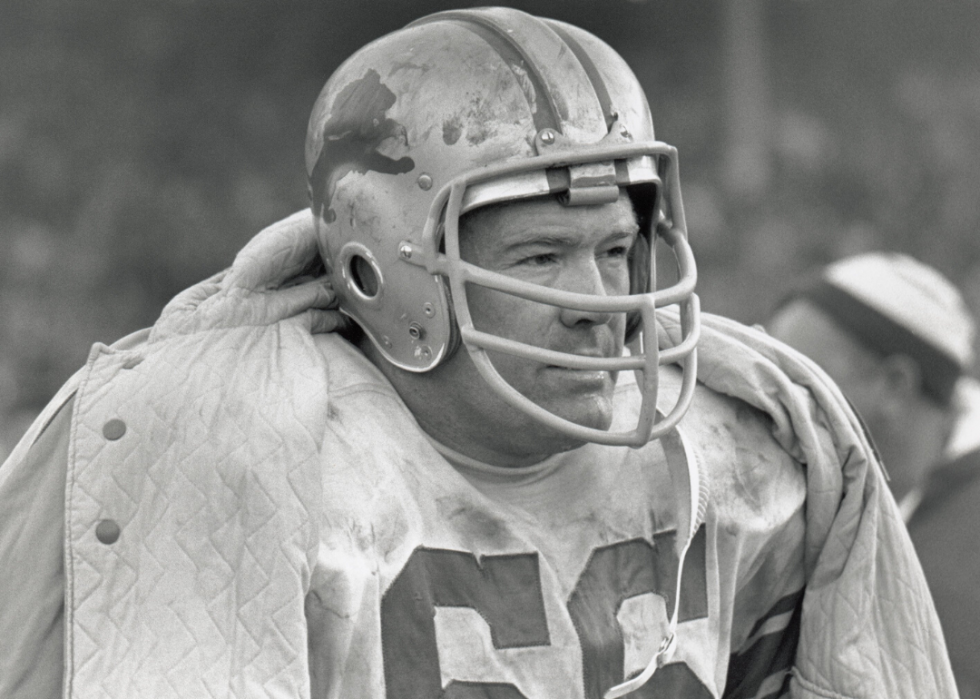
Then: Detroit Lions
Blue, silver, and white have been the predominant colors in the Lions’ jersey history. However, the team briefly wore red as a dedication to Alvin McMillin’s Indiana University heritage.
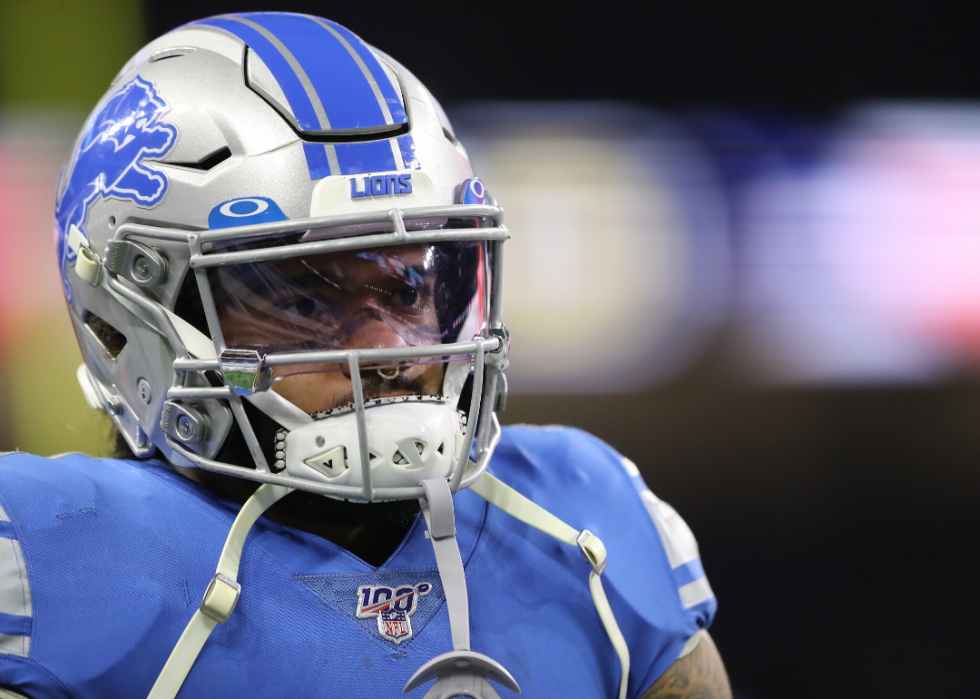
Now: Detroit Lions
The current Lions jerseys are much like the made-over uniforms the Lions debuted in 2009, except that the collar is blue. These jerseys have been worn in all 11 years of Matthew Stafford's career in Detroit, where he's thrown for over 41,000 yards.
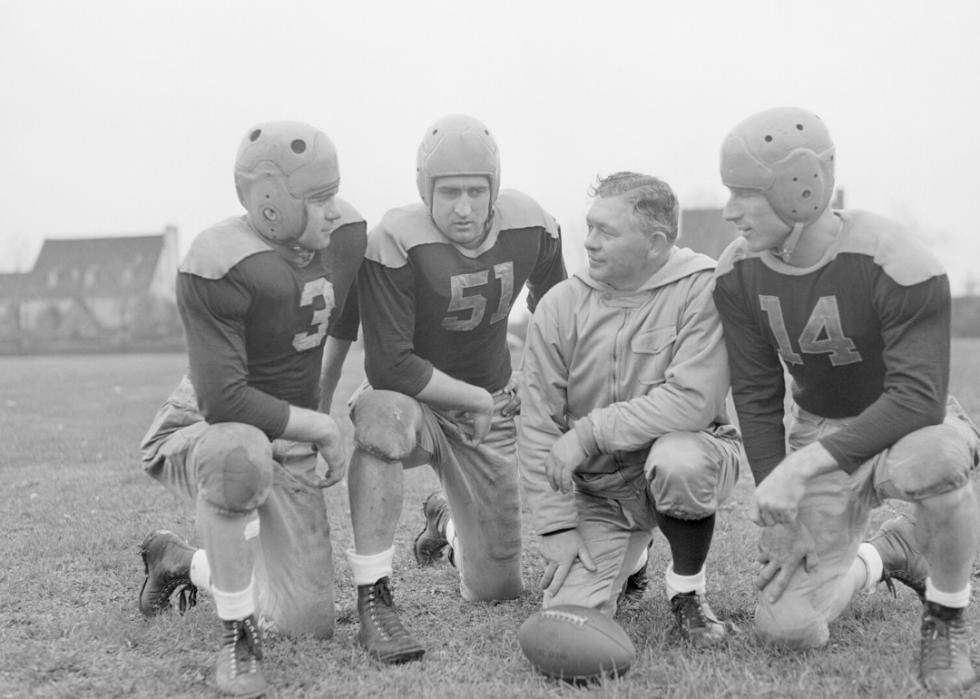
Then: Green Bay Packers
Although the Packers’ colors are now solely green and yellow, the team previously sported blue as a primary color for parts of 30 years from the 1920s to 1950s. Through the ’50s, the team also wore long sleeves.
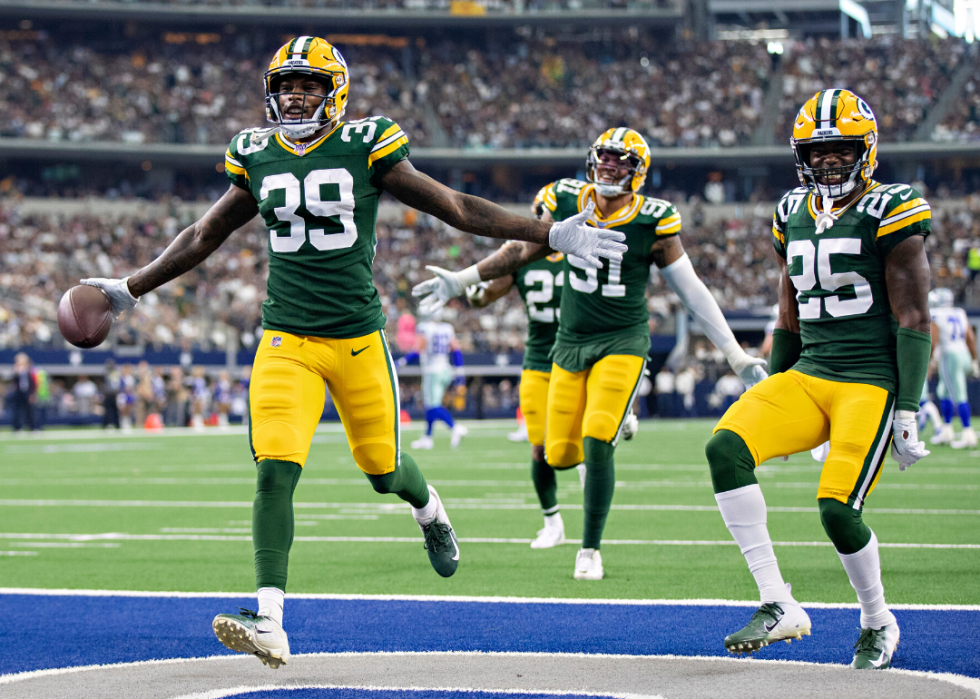
Now: Green Bay Packers
Much like the Cowboys, the Packers have an iconic look that they’ve rarely ever tweaked over the past half-century. The same green, yellow, and white threads worn by Aaron Rodgers were sported by Reggie White and Brett Favre. One slight change Green Bay has made on the road is occasionally wearing white jerseys with white pants.
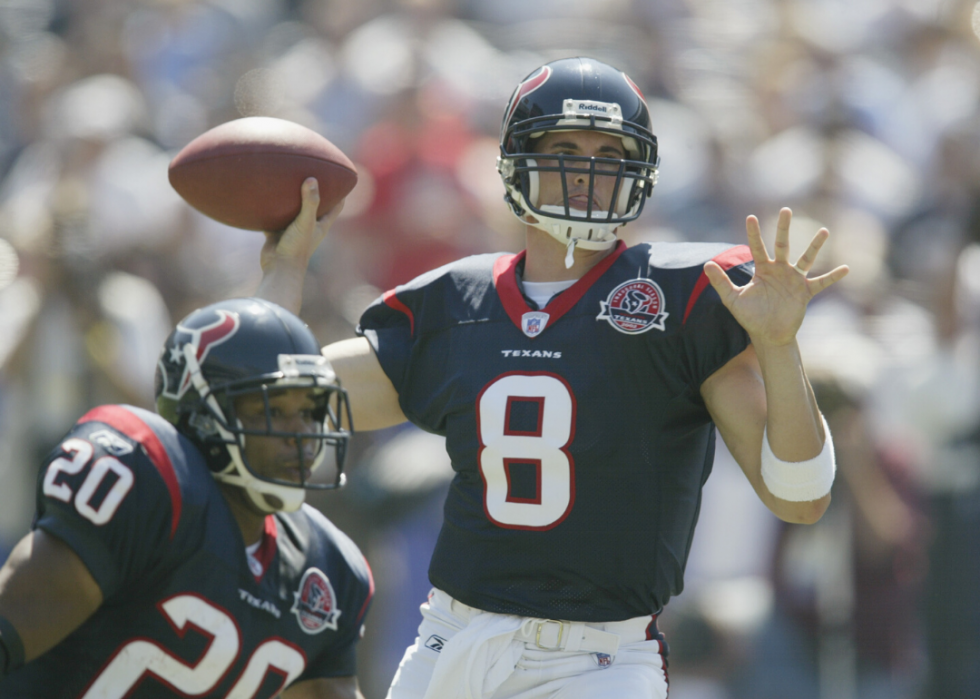
Then: Houston Texans
The most notable aspect of the Texans' inaugural jersey is the commemorative patch on the left chest. Although navy and red aren't the most bold colors for an expansion franchise (the 1990s saw a lot of turquoise), the combo has become a signature look for Houston football, not a flash in the pan.
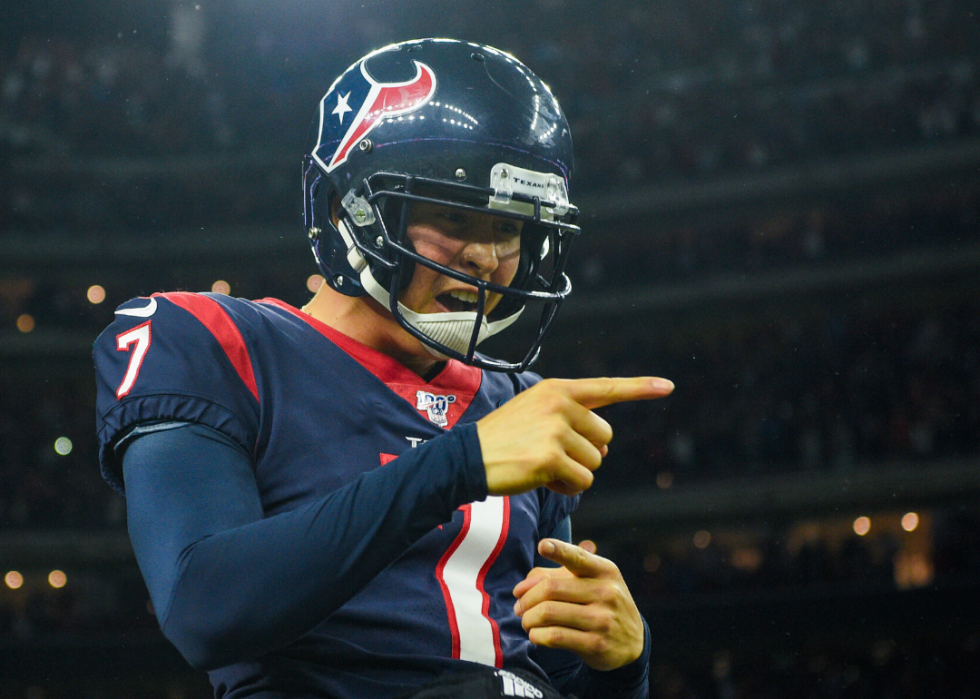
Now: Houston Texans
The Texans haven't really switched it up since entering the NFL in 2002, meaning J.J. Watt and David Carr have both sported the same look. The Apollos, Bobcats, and Stallions were other name considerations before Texans was chosen.
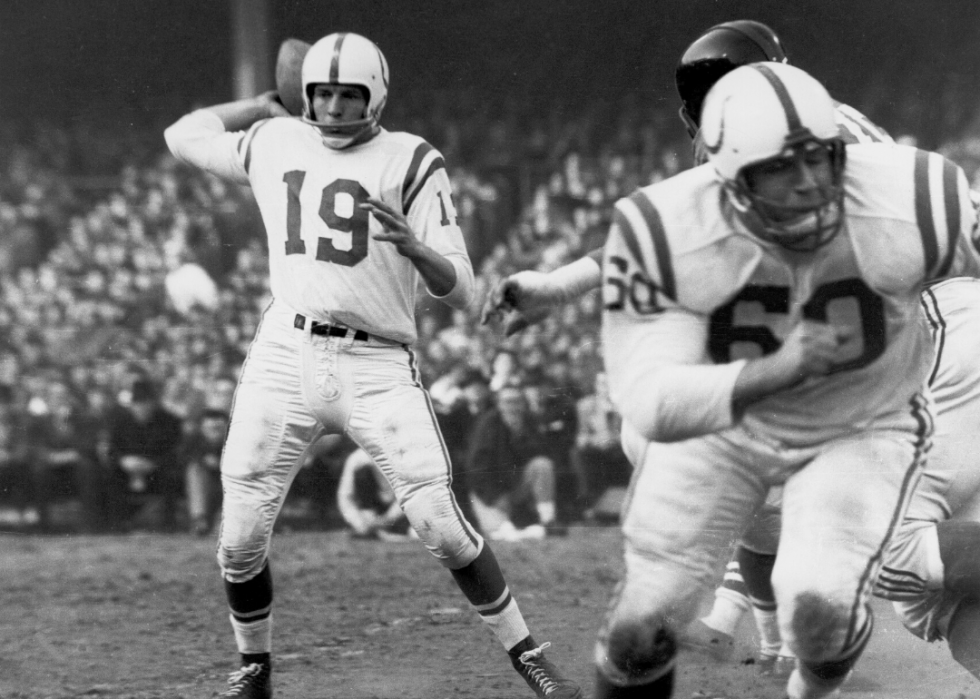
Then: Indianapolis Colts
Many teams have stripes around the shoulders, but the Colts have kept this look throughout most of their history, from Baltimore to Indianapolis. They were even included in a Johnny Unitas appearance on “The Simpsons.” These jerseys have numbers that are a bit more jagged than the rounded versions the team has worn for most of their time in Indiana.
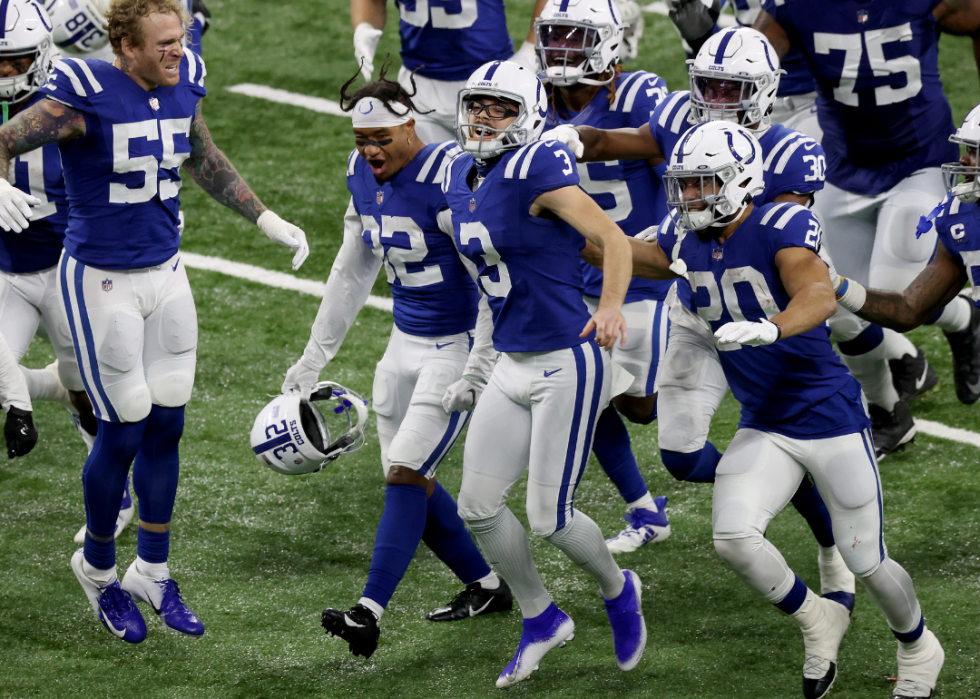
Now: Indianapolis Colts
When the Colts took to the field this season, their jerseys had a slightly altered look. The numbers on the classic blue-and-white jerseys are a throwback to the 1960s Colts teams, meaning new quarterback Philip Rivers will be rocking a style similar to that worn by Johnny Unitas.
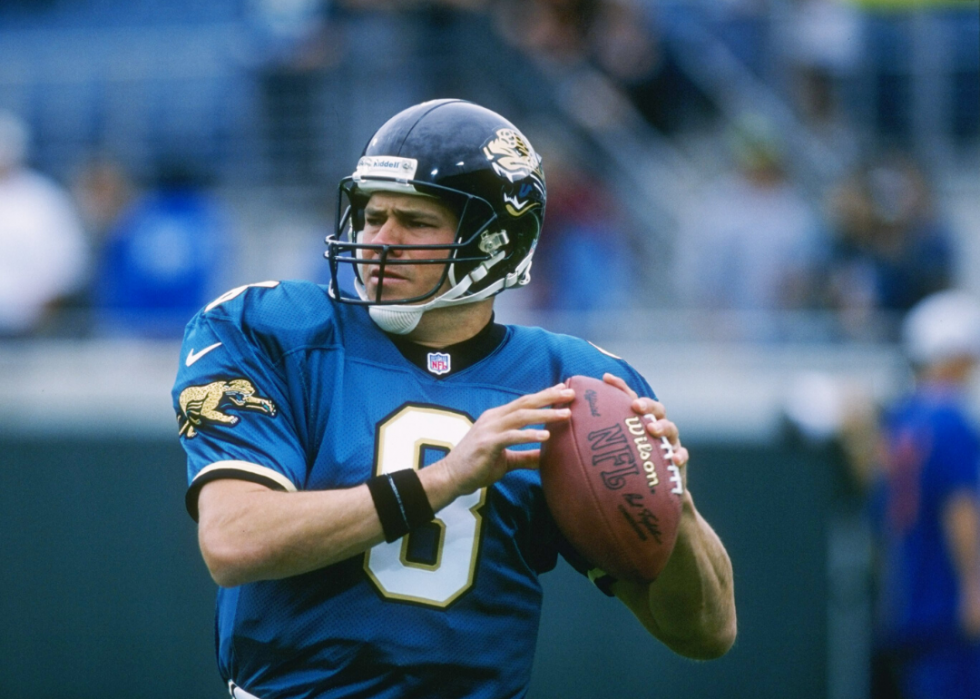
Then: Jacksonville Jaguars
The Jaguars’ first jerseys were notable for their striped-cuff sleeves and the jaguar logo above them. The use of a full black collar is another design perk that didn’t stand the test of time. Mark Brunell, who took over as starter during the Jaguars’ first season, made three Pro Bowls in nine years in Jacksonville.
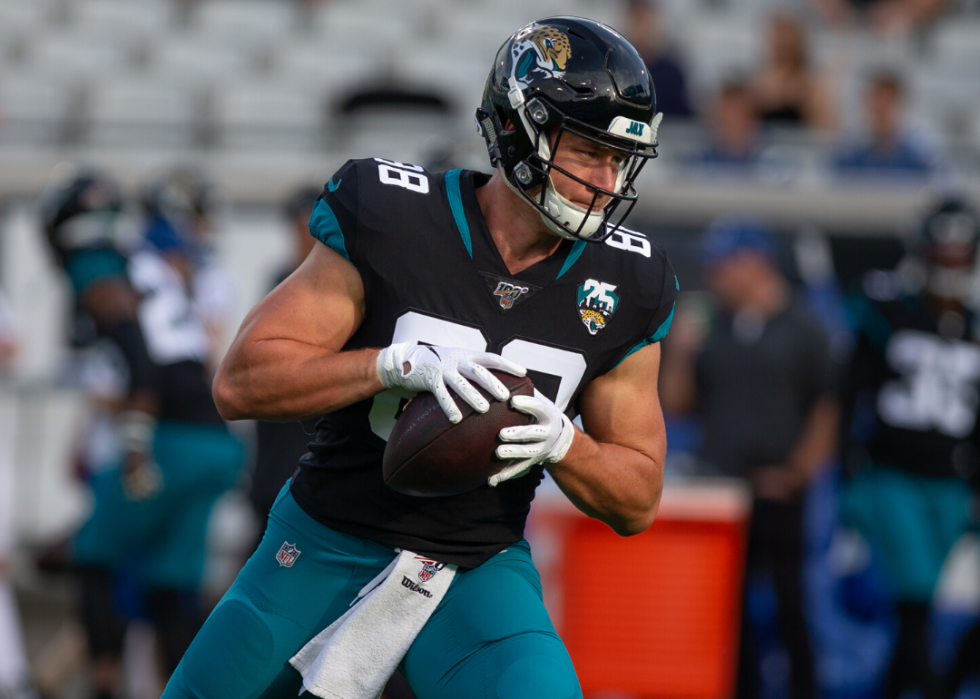
Now: Jacksonville Jaguars
In 2018, the Jaguars introduced a more simplified look with no outline around the numbers and a lack of stripes (as opposed to their big-cat brethren, the Bengals). The Jaguars are one of the rare teams with a primary logo on the chest of the jersey.
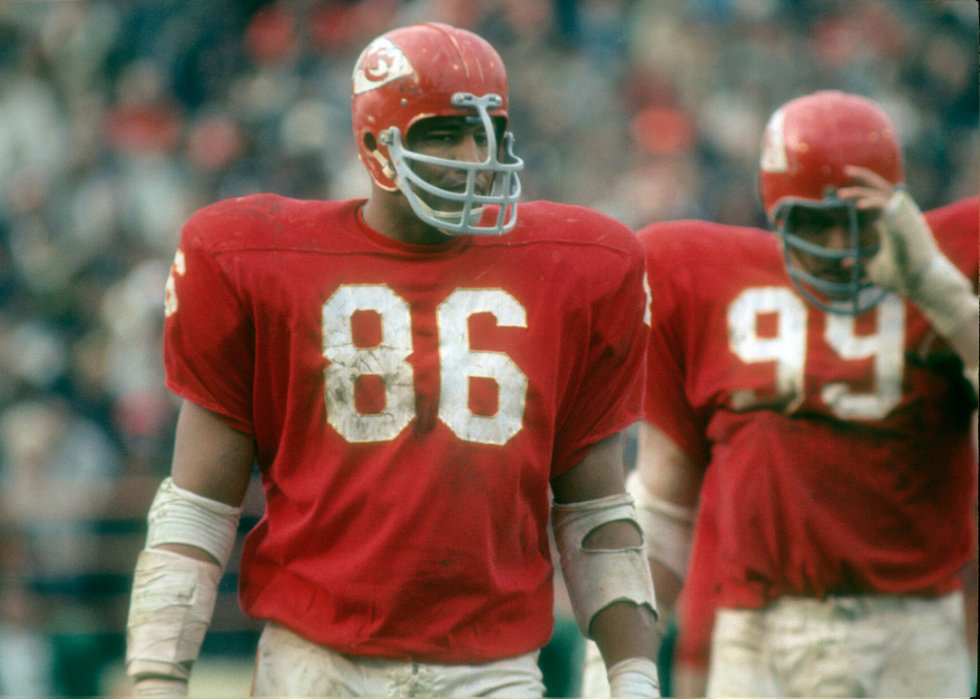
Then: Kansas City Chiefs
Older Chiefs jerseys did not have multi-stripes on the sleeves but did have yellow outlining on the numbers, which remains today. The Chiefs began play in 1960 as the Dallas Texans.
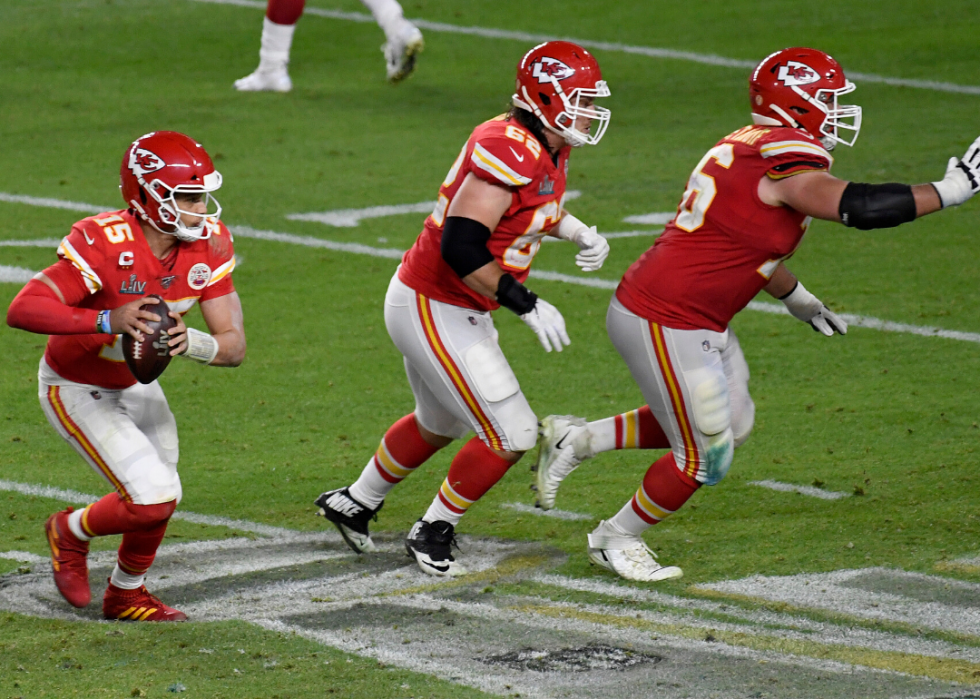
Now: Kansas City Chiefs
The reigning Super Bowl champs are another team that rarely tinkers with their appearance. The same jersey Patrick Mahomes wore in Super Bowl LIV resembles the kind Len Dawson wore when leading the Chiefs to a Super Bowl I appearance, except for the stripes on the sleeves.
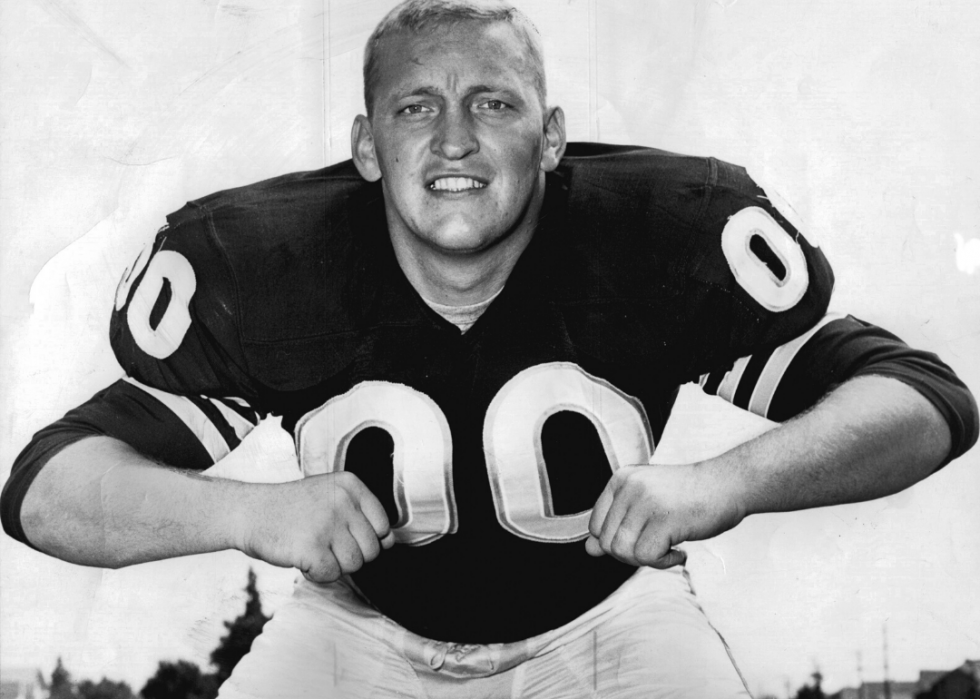
Then: Las Vegas Raiders
It’s hard to tell from this photo, but these jerseys are actually gold and black. The Raiders began incorporating silver around 1963 and also ditched the stripes on the sleeves. No matter what Jim Otto wore, he mauled opposing lineman during a Hall of Fame career.
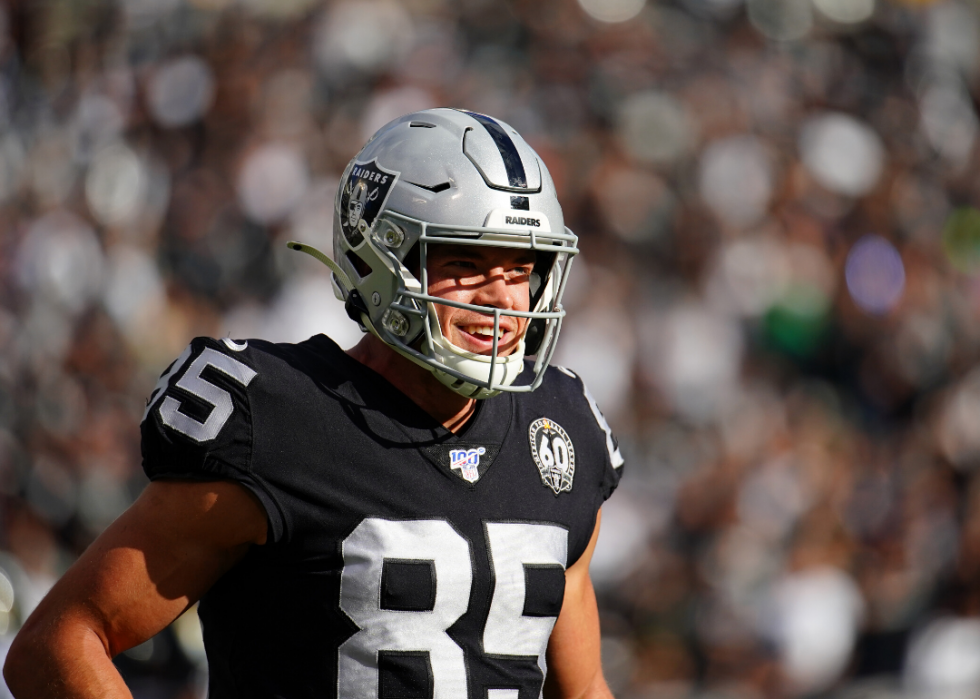
Now: Las Vegas Raiders
Silver and black have been the Raiders’ norm for over 50 years, worn by Bo Jackson, Ken Stabler, and Derek Carr. However, with the team’s move to Las Vegas this season, could a change be in the cards? A return to gold would fit in with the Vegas theme.
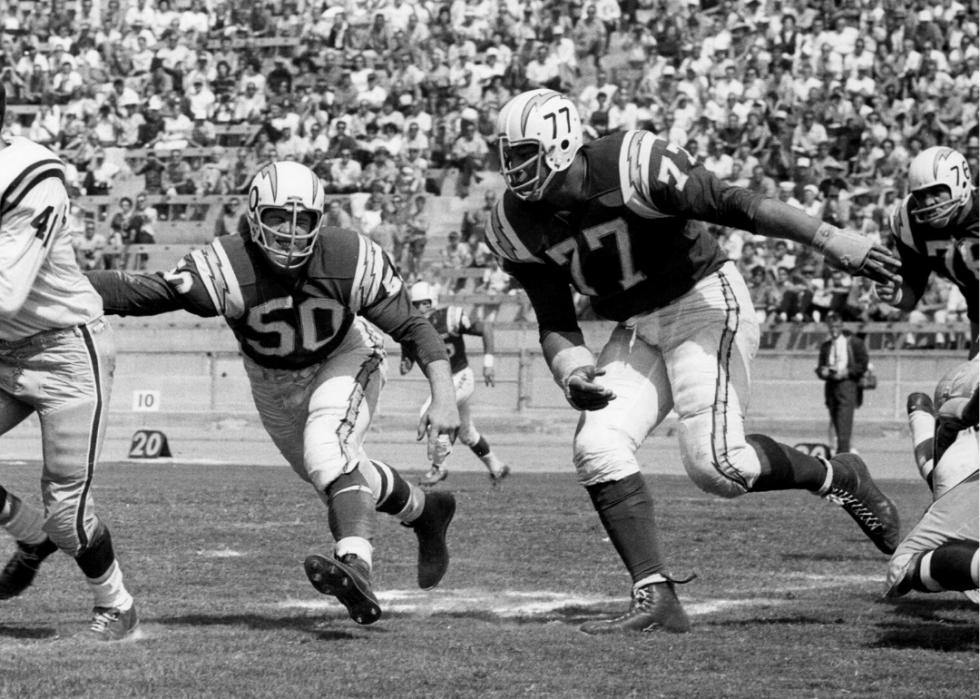
Then: Los Angeles Chargers
The Chargers' jerseys have always stood out with the lightning-bolt shoulder design. That endured the move from San Diego to Los Angeles and adorned players like Ernie Ladd, who later became a professional wrestler.
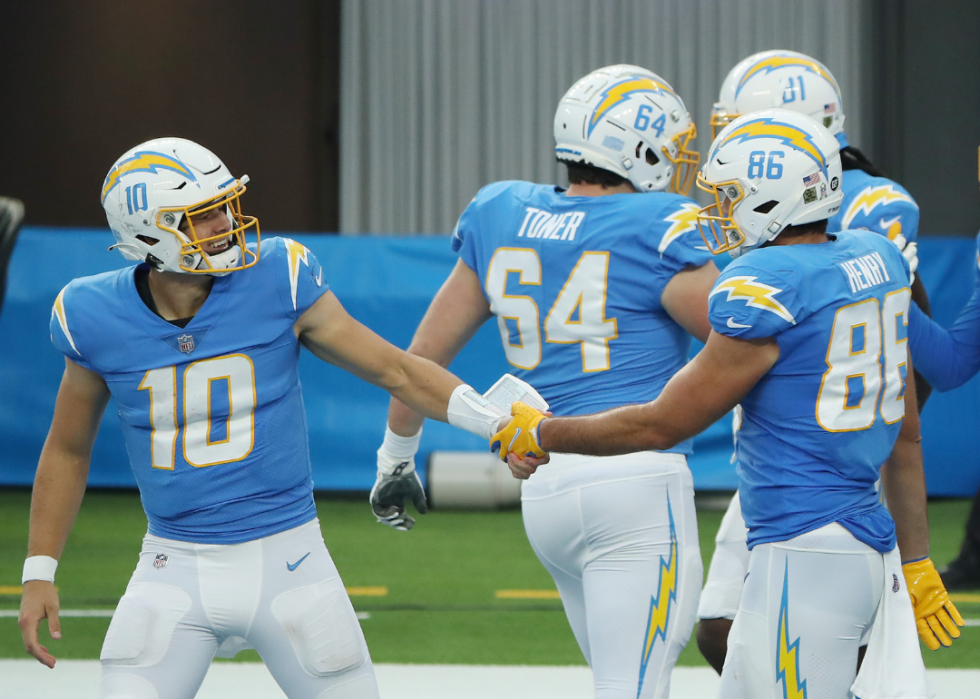
Now: Los Angeles Chargers
As the Chargers prepare to open a new stadium, they’ve broken out some new duds this spring. The jerseys have bigger numbers and italicized names on the back and draw inspiration from every era of Chargers football. During the Philip Rivers era, the team frequently wore a lot of powder blue, as seen in this photo.
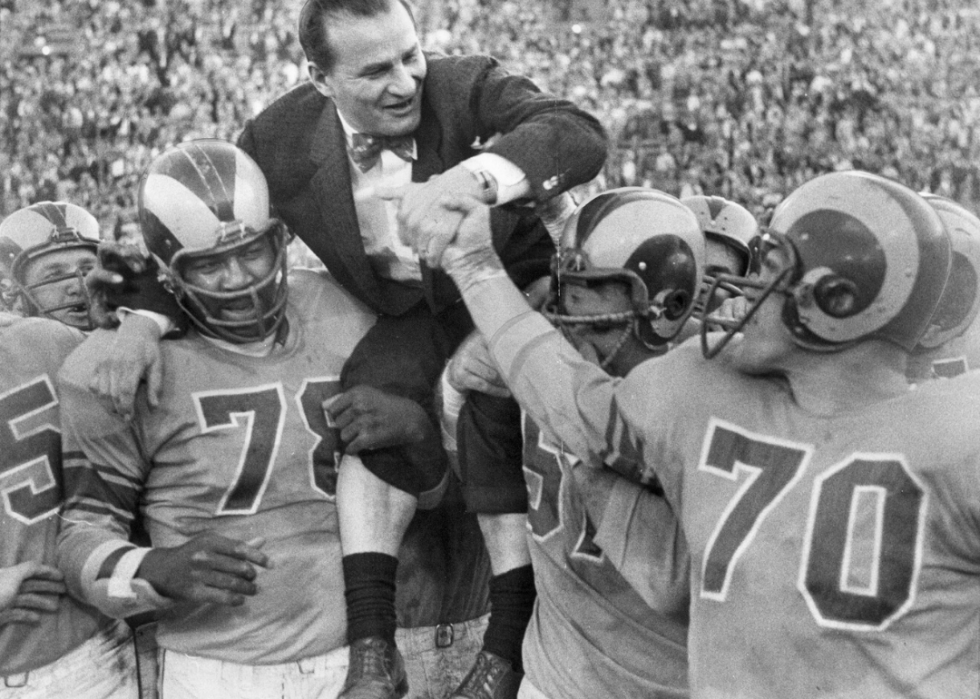
Then: Los Angeles Rams
The Rams’ 1950s jerseys were missing a notable design. The team, which originally played in Cleveland, didn’t add ram-horn stripes until the 1970s.
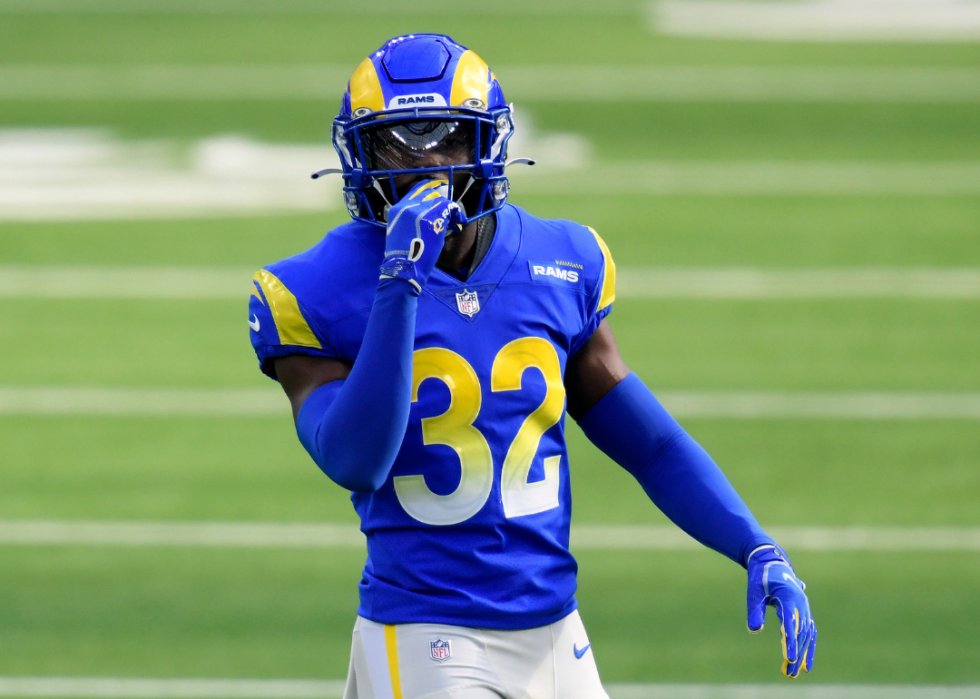
Now: Los Angeles Rams
When the Rams returned to Los Angeles in 2016, they slowly began integrating their classic blue-and-yellow jersey look that had disappeared while in St. Louis. The jersey style worn by Eric Dickerson and other Rams replaced a gold-and-navy style made popular by Kurt Warner, Marshall Faulk, and Torry Holt. In May 2020 the team unveiled new uniforms that update the horn of the ram and introduce an off-white, called "bone" white, to the jersey rotation.
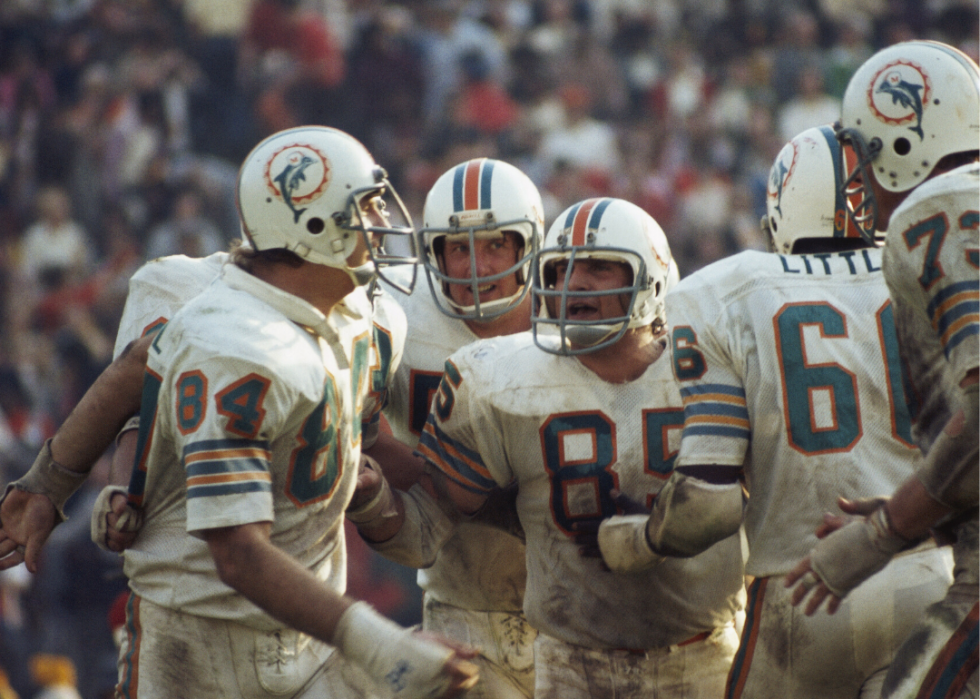
Then: Miami Dolphins
The Dolphins have always worn clean-looking jerseys with the combination of light blues and orange which exemplify the style of south Florida. These beauties were worn by Nick Buoniconti and the rest of the 1972 Dolphins, who remain the only undefeated champions in NFL history.
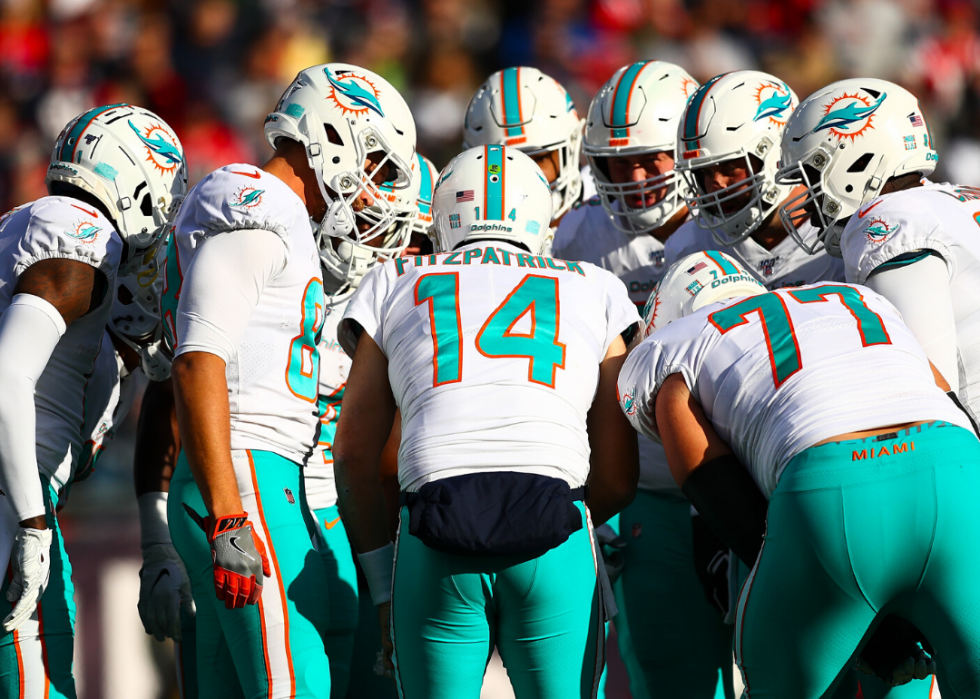
Now: Miami Dolphins
In 2018, the Dolphins eliminated darker blue outlining from their uniforms, focusing on aqua blue and bright orange. This jersey could become known for the era of Tua Tagovailoa, who was drafted in the first round by Miami in April.
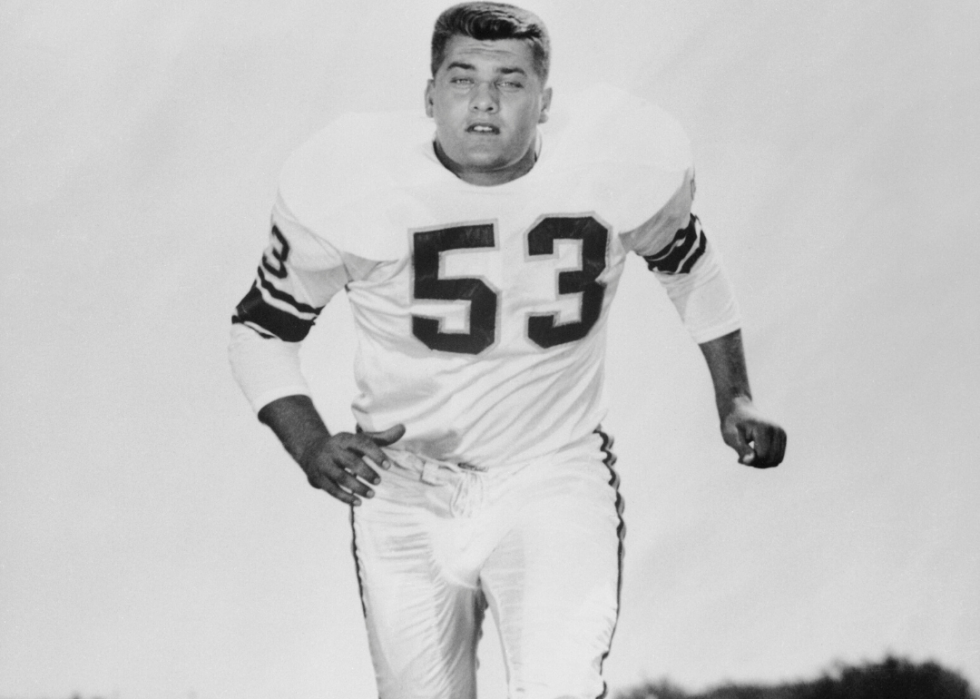
Then: Minnesota Vikings
Vikings jerseys have always been linked to purple, white, and yellow. Mick Tingelhoff, seen here, played his entire career in those colors and later made the Hall of Fame.
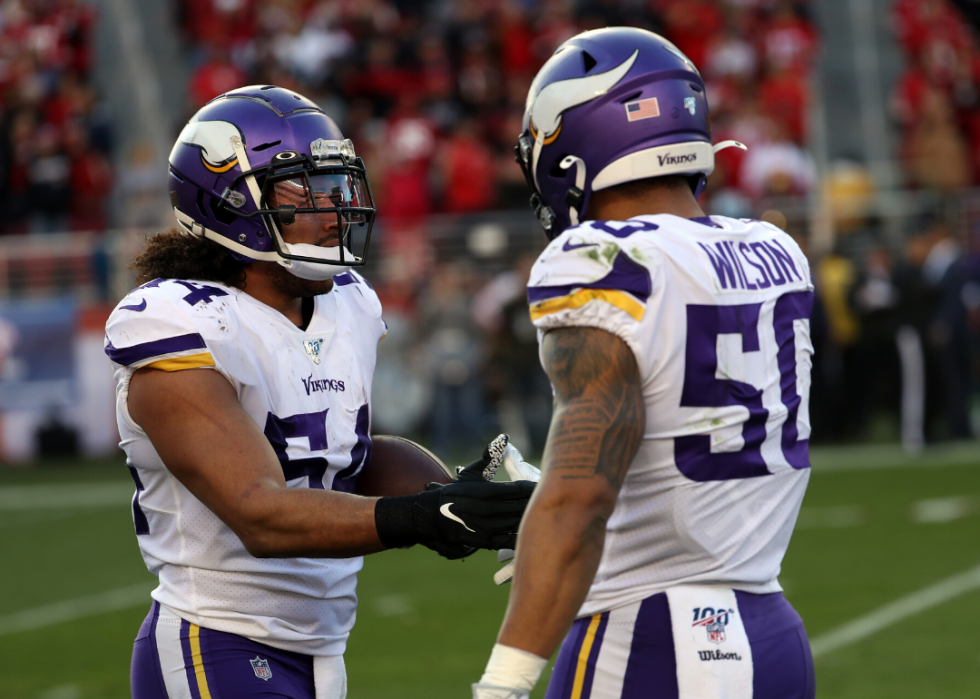
Now: Minnesota Vikings
The Vikings ditched the outlining on their numbers and changed to more simplistic stripes with their 2013 reboot. These were the last jerseys Adrian Peterson wore in the purple and gold, now sported by Adam Thielen and Peterson's heir, Dalvin Cook.
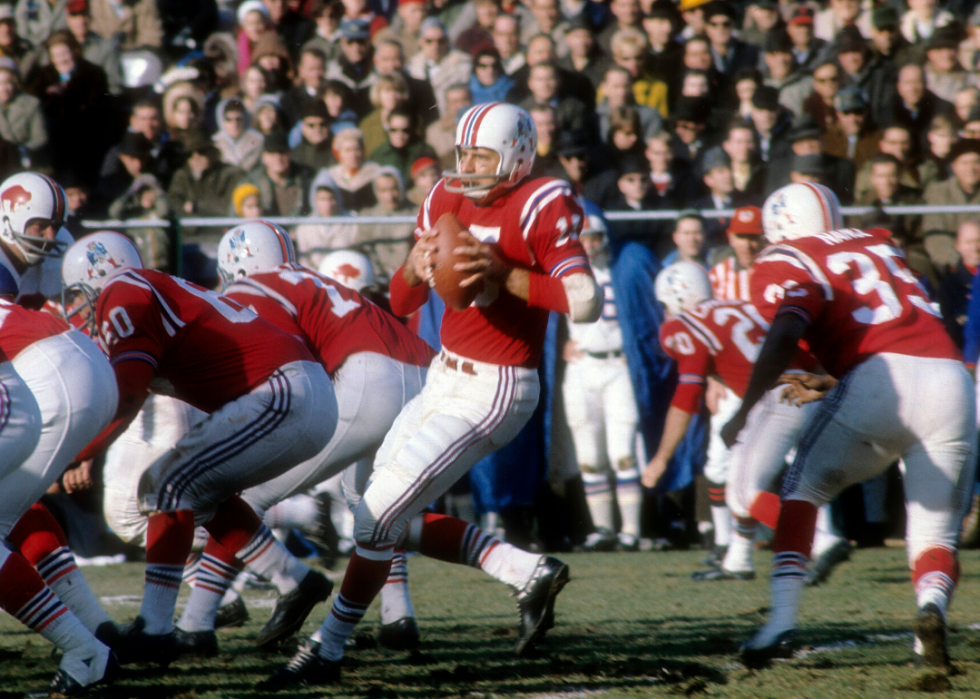
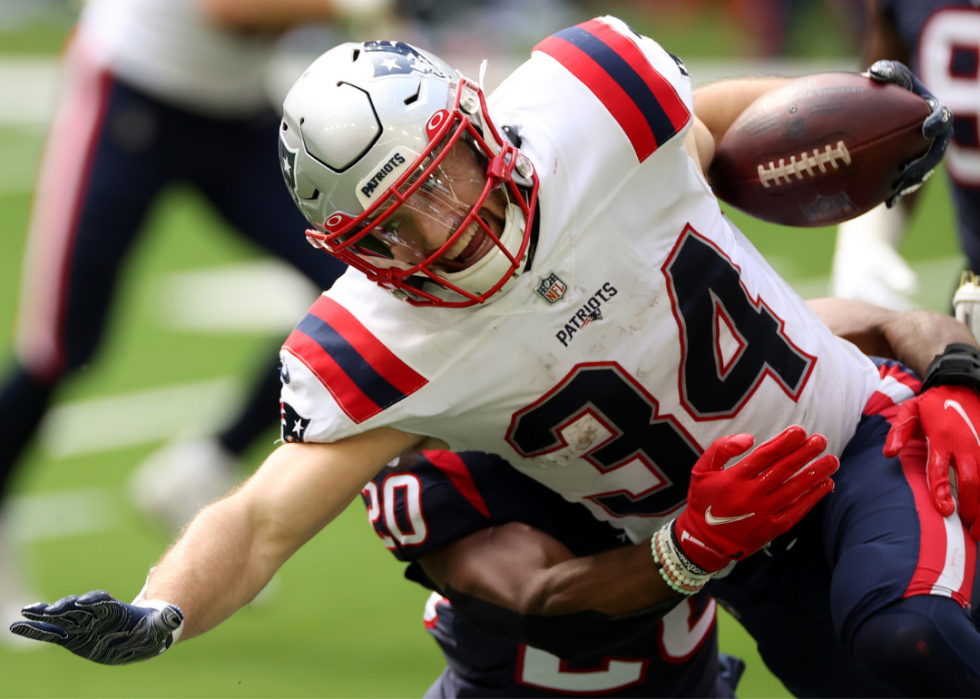
Now: New England Patriots
The primary jerseys the Patriots rolled out for the 2020 season represented their "Color Rush" look from previous years. The new navy home jerseys indicate a changing of the guard, as this will be the first season in New England without Tom Brady since 1999.
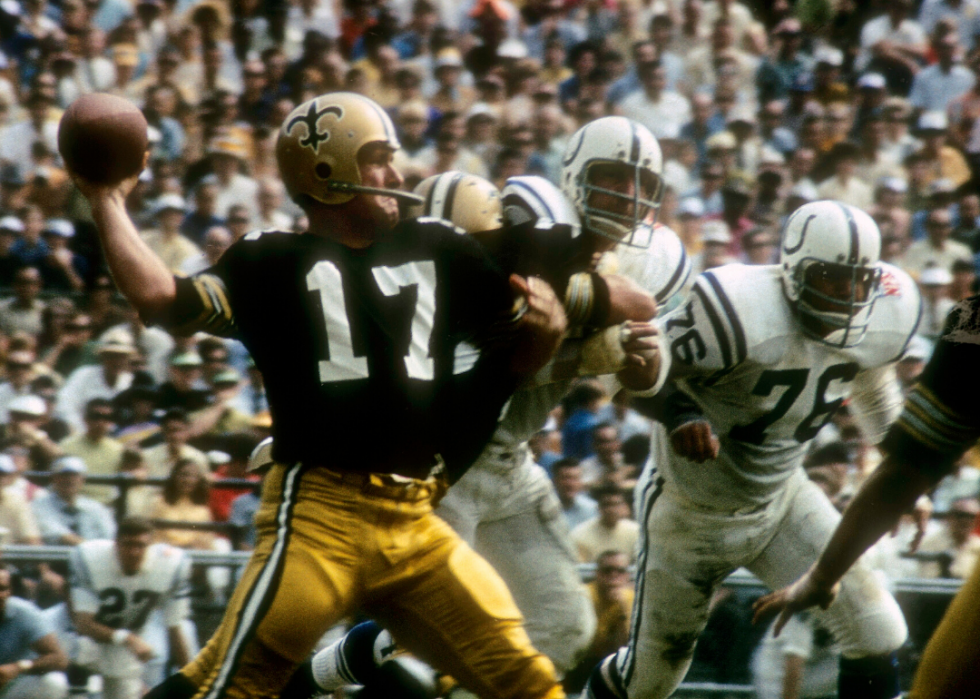
Then: New Orleans Saints
The early Saints jerseys had the same colors as today but lacked a few noticeable tinges of decor. Gold outlining on the collar was absent, and striped sleeves played a more prominent role in the uniforms worn by Billy Kilmer, who played four seasons in New Orleans.
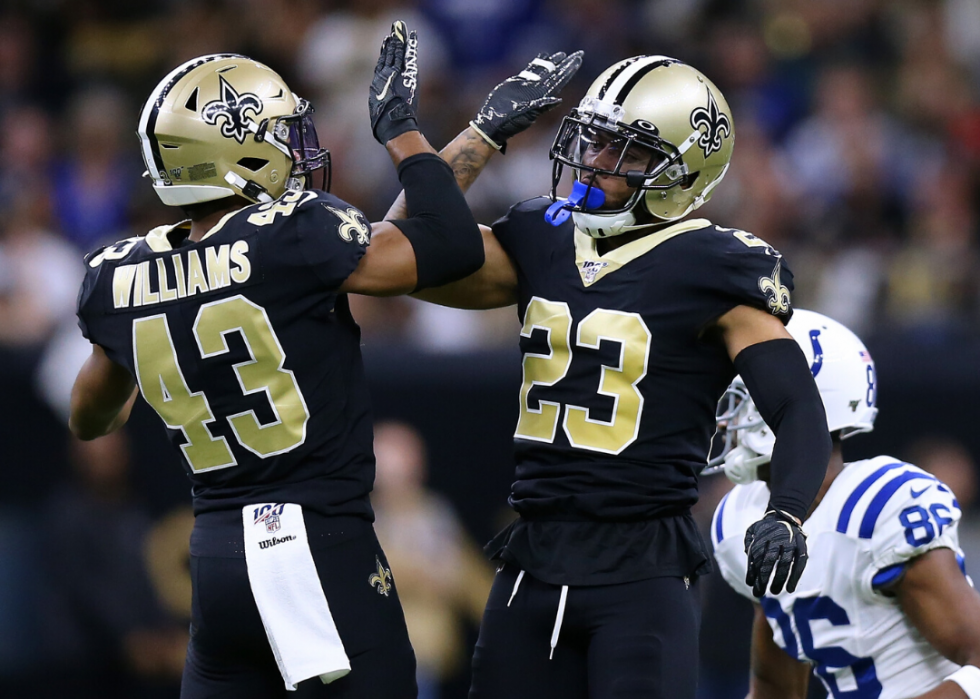
Now: New Orleans Saints
The Saints jerseys worn by Drew Brees and Alvin Kamara remain very much the same from when the franchise came marching into the NFL over 50 years ago. In 1996, the team added a patch of the fleur-de-lis on the sleeves, although one had appeared in earlier versions inside a Louisiana state outline.
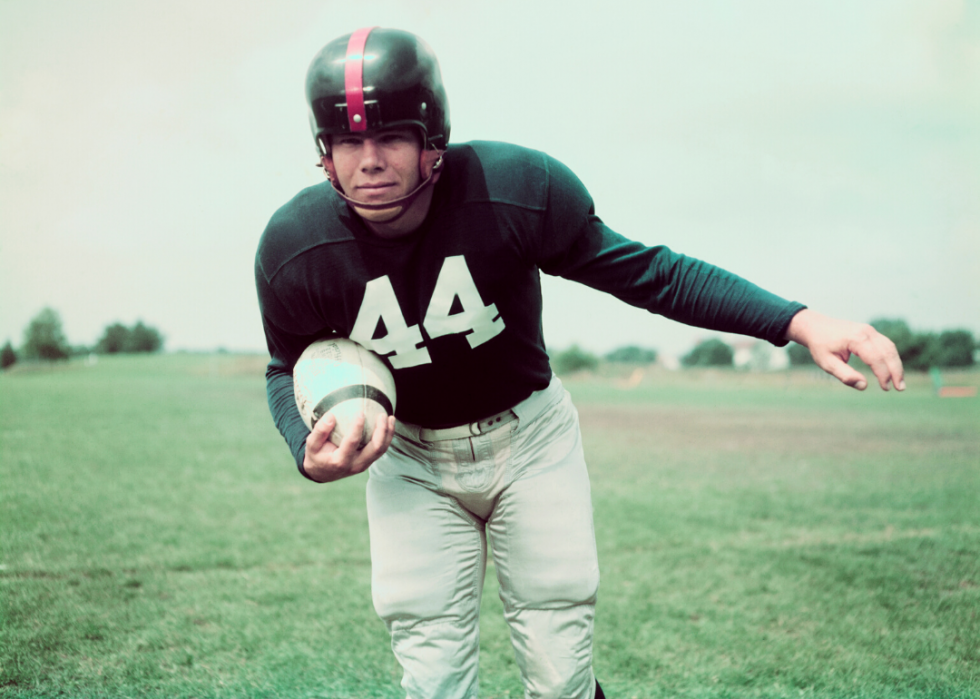
Then: New York Giants
The Giants have always kept a pretty basic look, and these 1950s-era jerseys are as basic as you can get. During this period, the team played its games in the Polo Grounds and Yankee Stadium. Blue, white, and red remain the Giants’ primary colors today.
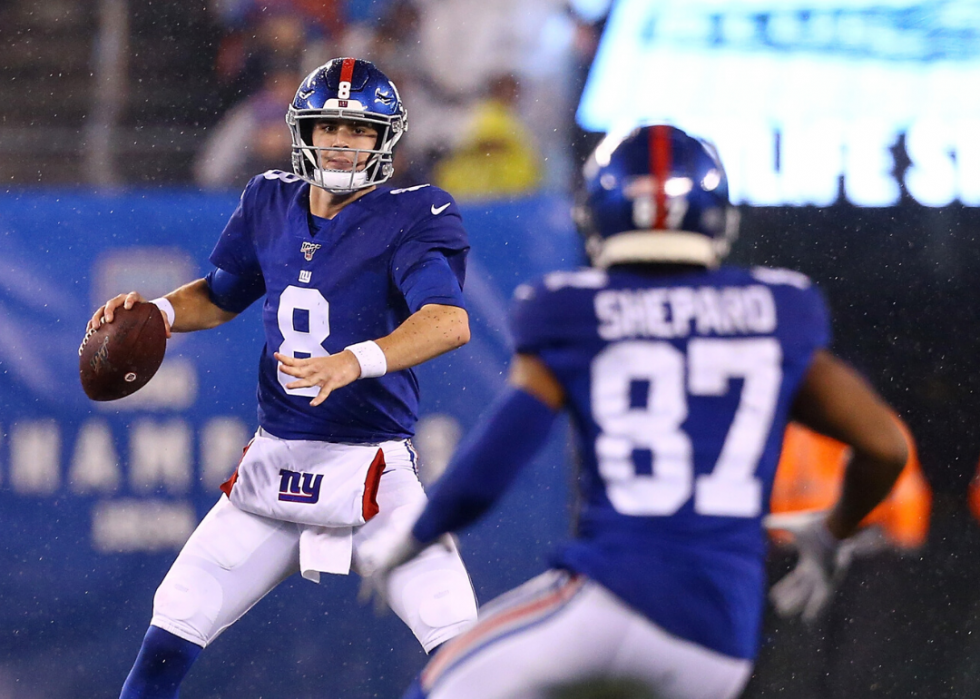
Now: New York Giants
There's a reason why the Giants' nickname is Big Blue. The current home uniform has no stripes or outline colors but is just flush with blue and white numbers (and a small NY insignia on the chest). The Giants wore a similar version of this jersey in the early 2000s, but with a red collar end.
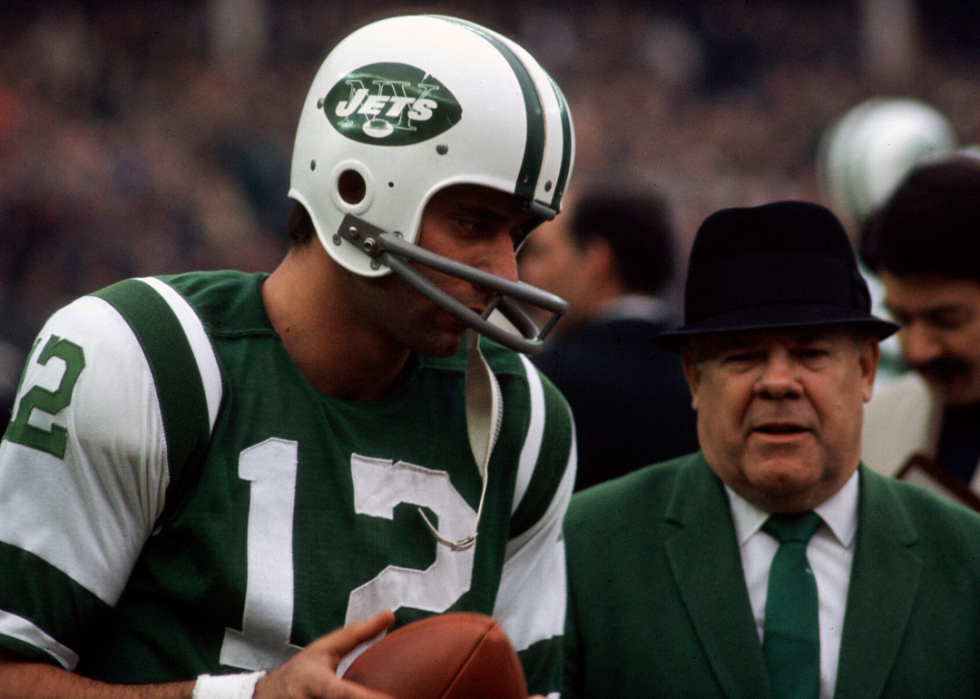
Then: New York Jets
They’re not fur coats, but the green-and-white jerseys worn by Joe Namath were still pretty sleek. This jersey style was worn as the Jets skyrocketed their way to the top of the AFL and won Super Bowl III. The team reintroduced an updated version of this layout in the late 1990s.
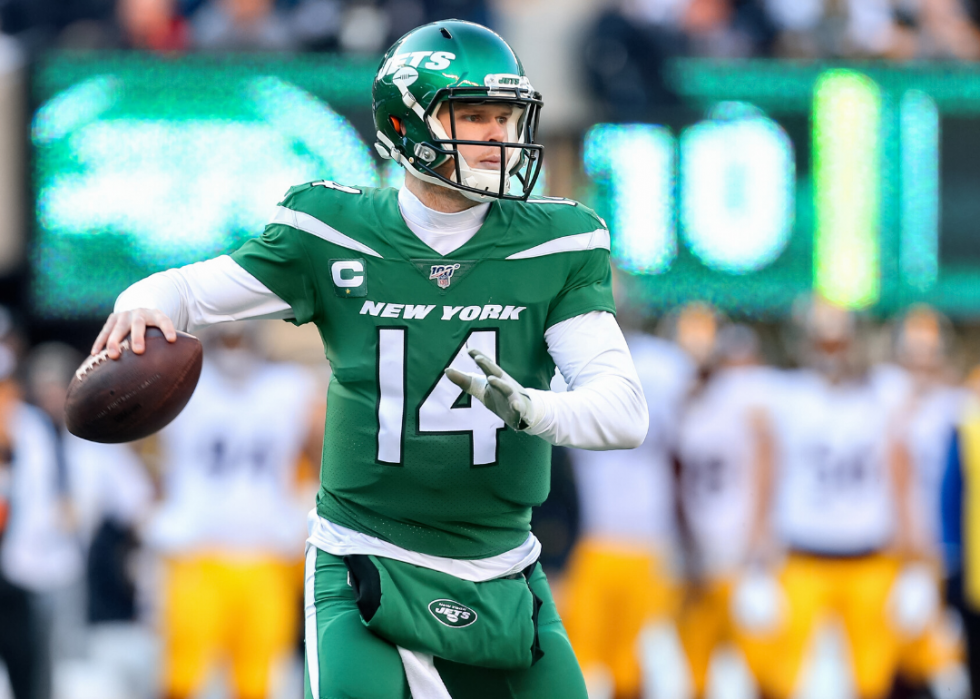
Now: New York Jets
In 2019, the Jets went to a more traditional shade of green (called Gotham green) and added black lining to their jerseys and "New York" across the chest for the first time. Of course, this neglects the fact that the team trains and plays its home games in New Jersey.
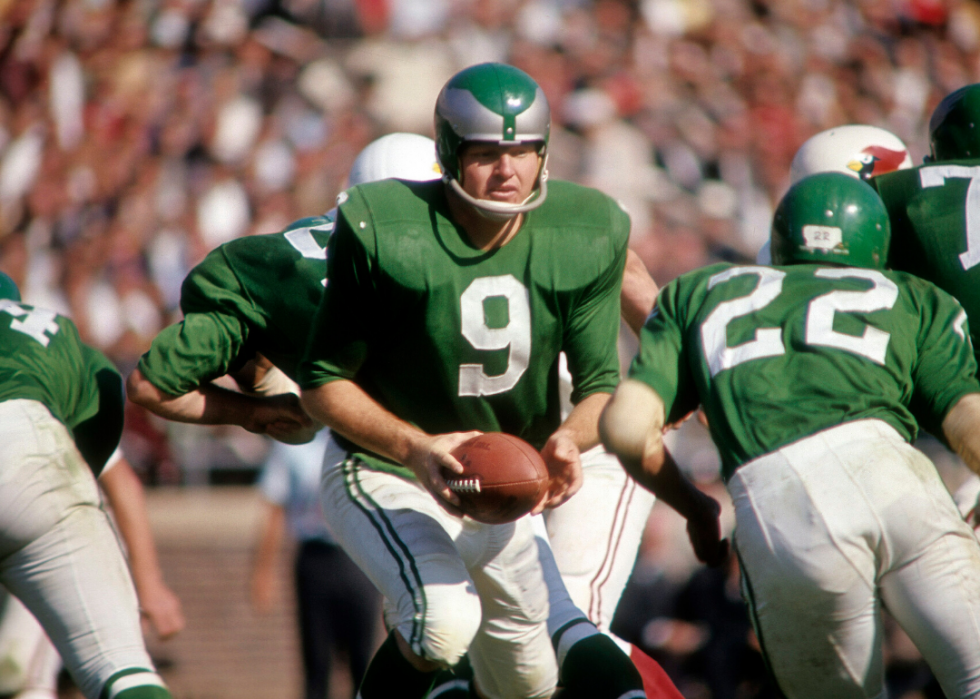
Then: Philadelphia Eagles
Sonny Jurgensen, seen here, began a Hall of Fame career littered with highlights in Philadelphia, but his jerseys were pretty basic. Green and white numbers don't leave much to the imagination, but the team would eventually incorporate stripes onto the sleeves.

Now: Philadelphia Eagles
In 1996, the Eagles got rid of kelly green as their main color and introduced a shade similar to the current iteration. Although these jerseys were the ones worn when Philadelphia won its only Super Bowl in 2018, a return to kelly green has been rumored for years.
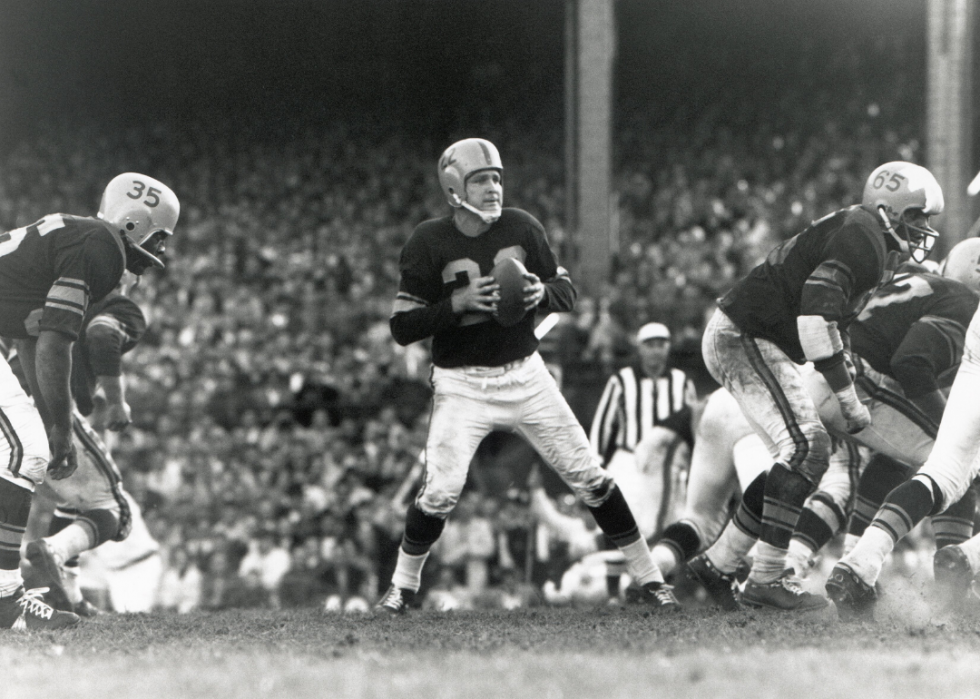
Then: Pittsburgh Steelers
Older Steelers jerseys were notable for the yellow stripes on the sleeves which remained for much of the ensuing years, although sometimes with the addition of white outlines. Bobby Layne donned this look while finishing a Hall of Fame career in Pittsburgh.
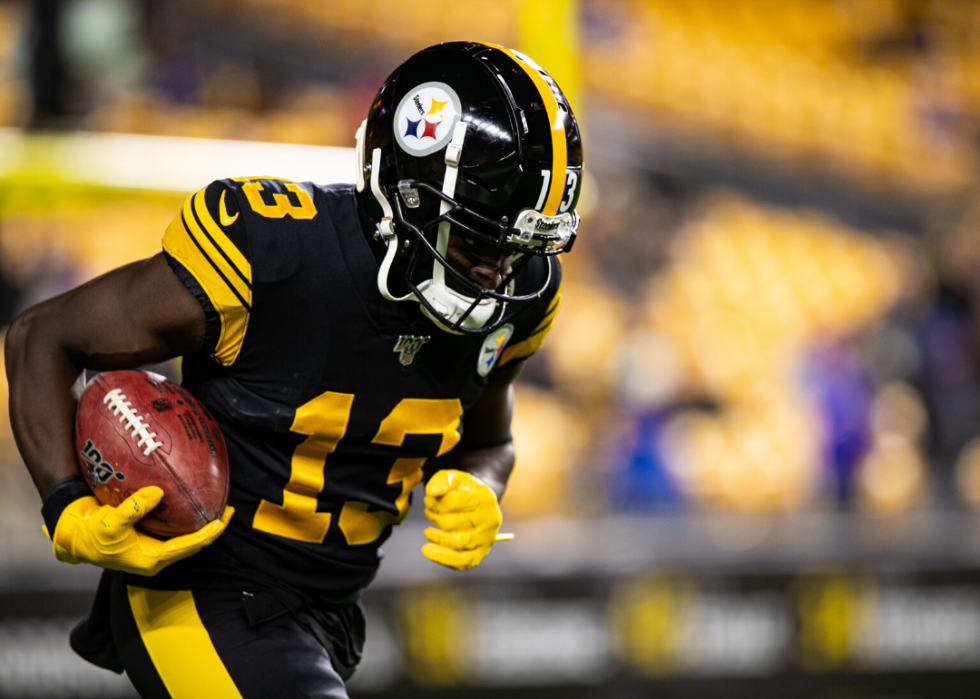
Now: Pittsburgh Steelers
The Steelers introduced a new fad in 1997 by going with italicized jersey numbers. Last season, the team occasionally wore jerseys with block numbers that adorned the likes of Franco Harris and Terry Bradshaw when Pittsburgh was a dominant team in the AFC.
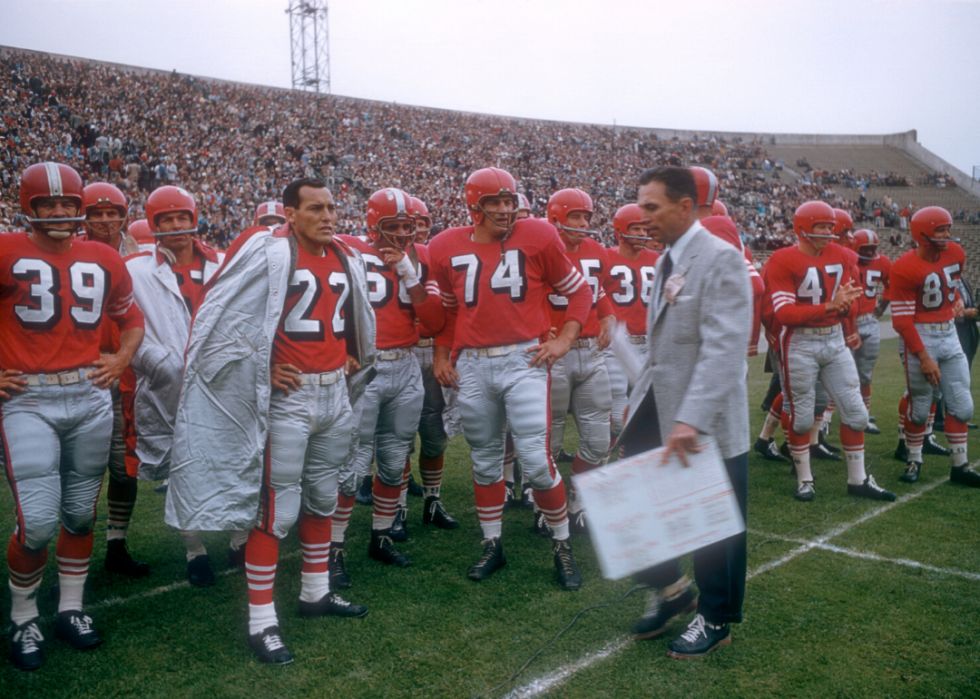
Then: San Francisco 49ers
The 49ers' early jerseys had a unique look with shadowed numbers. One notable absence is the lack of gold pants, which arrived on the 49ers sidelines in 1957.
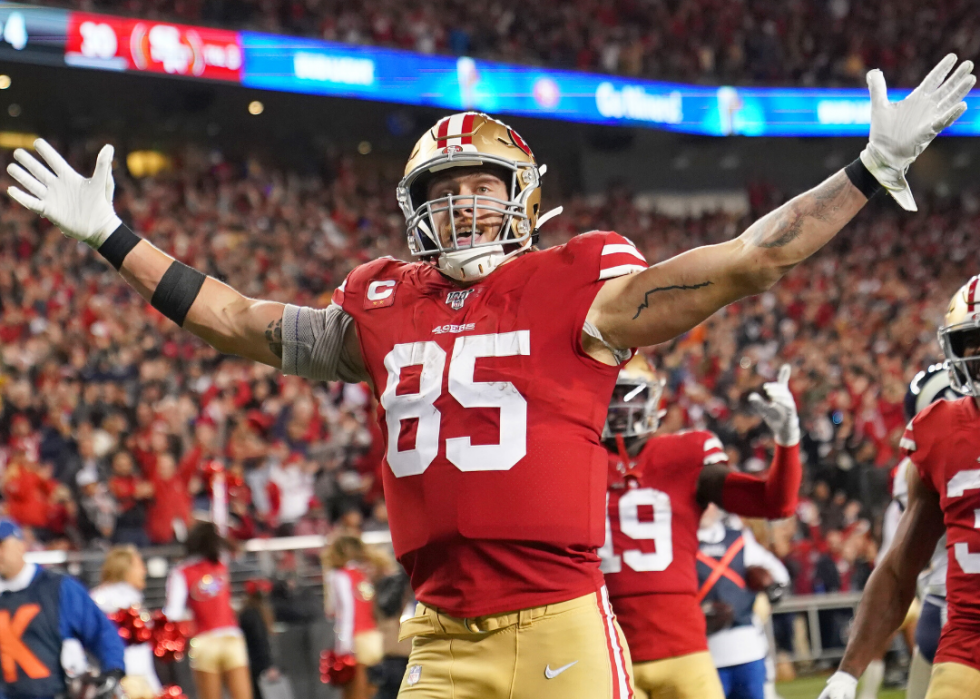
Now: San Francisco 49ers
After wearing jerseys with heavy outlining on the numbers for much of the 1990s and 2000s, the 49ers reverted to the look of their 1980s glory days in 2009. The only difference in the duds worn by Jimmy Garoppolo and Joe Montana is the small 49ers insignia across the chest.
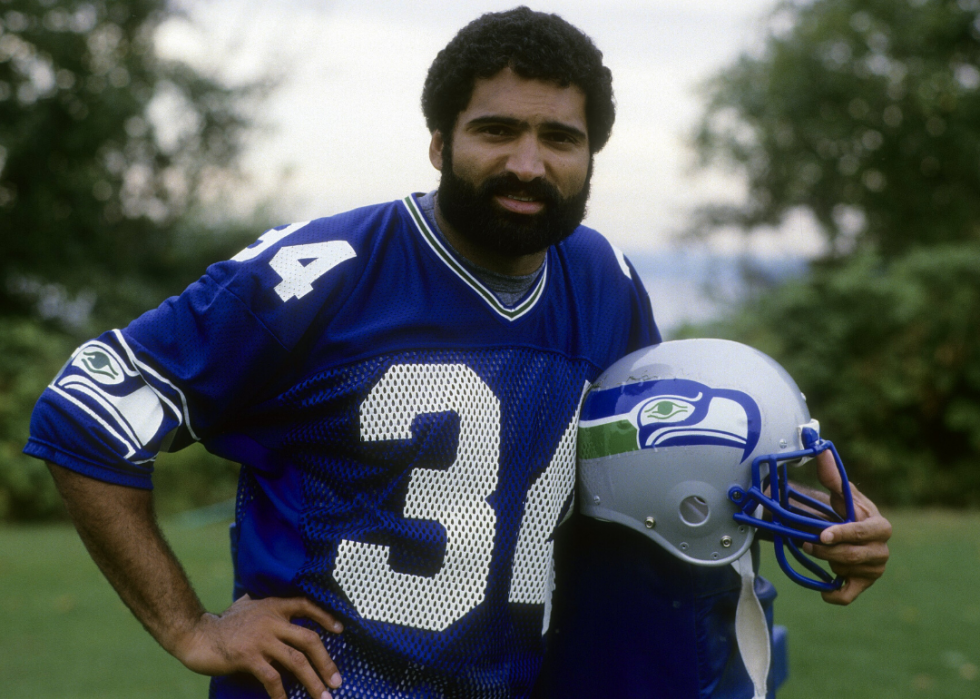
Then: Seattle Seahawks
Franco Harris wound down his career in Seattle, wearing these blue jerseys that featured a large Seahawks logo on the sleeve. Silver, green, and blue were the team’s primary colors through the 1980s, when Steve Largent led Seattle in receiving.
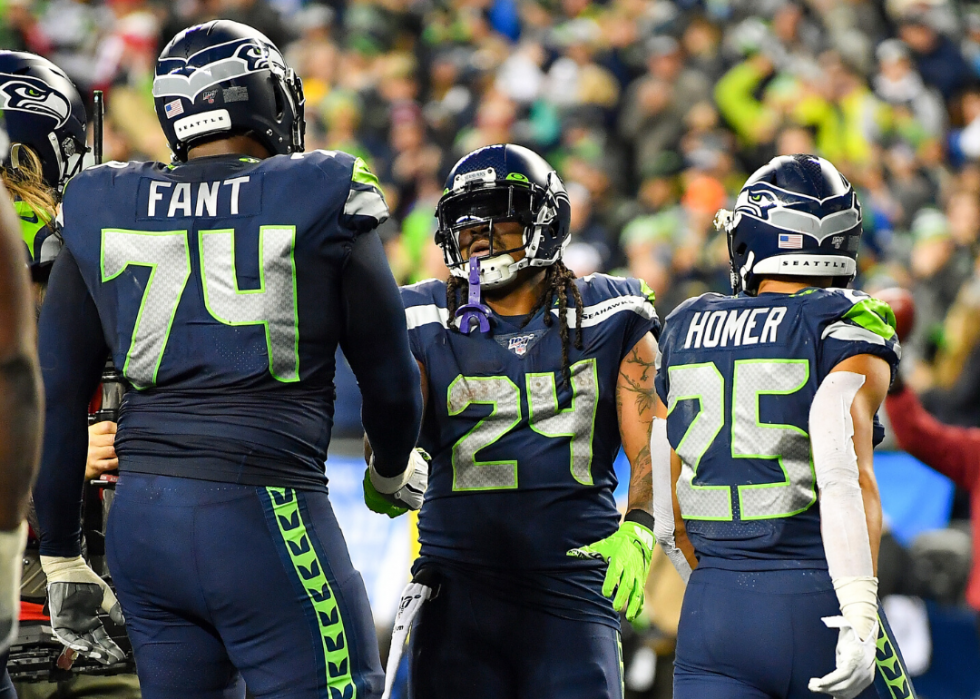
Now: Seattle Seahawks
The Seahawks made big changes to their jerseys in 2012. From the neon green outlining to the unique shoulder design, the Seahawks stood out from the rest of the league and wore these jerseys when Russell Wilson and company captured the franchise's first championship in Super Bowl XLVIII.
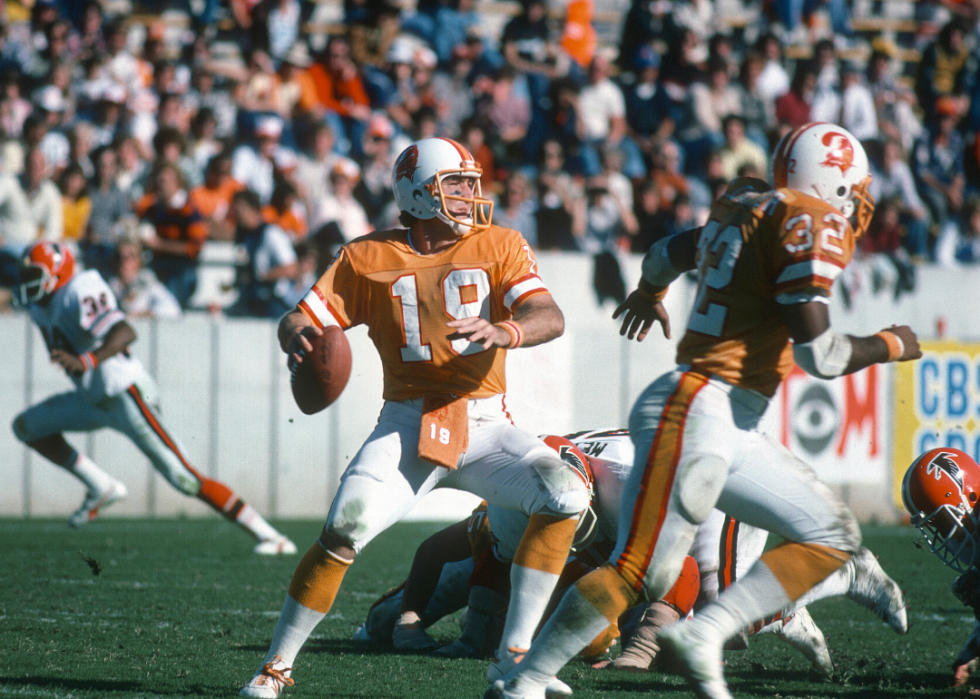
Then: Tampa Bay Buccaneers
Anybody in the mood for a creamsicle? The Buccaneers’ first jerseys were nothing like the NFL had seen before, openly garish and bright. The team wore orange, red, and white throughout the mid-1990s but only made 10 playoff appearances since entering the league in 1976.
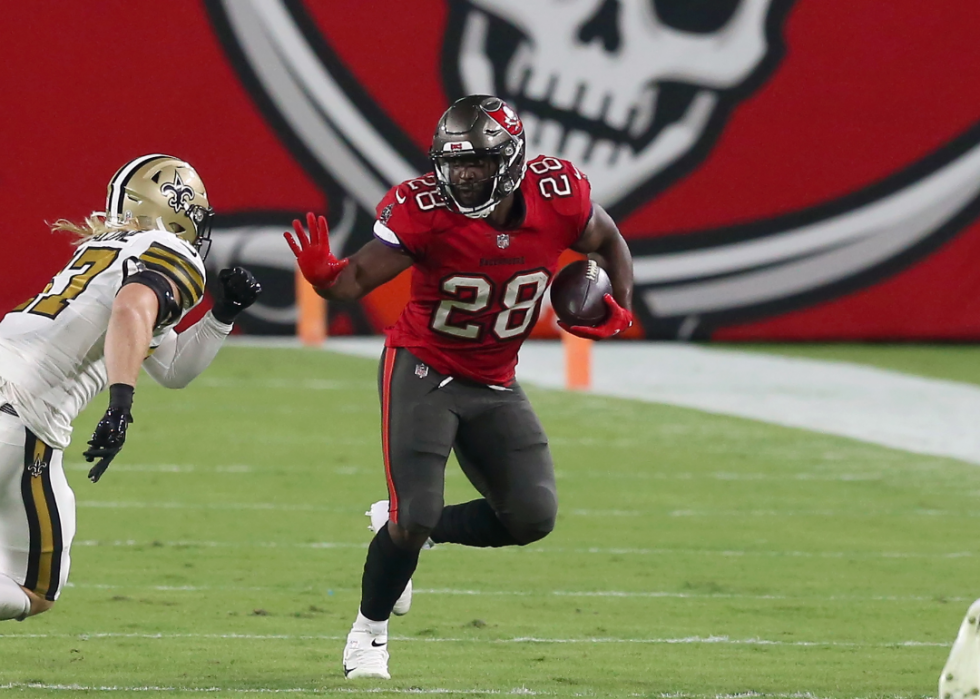
Now: Tampa Bay Buccaneers
The new Buccaneers jerseys, worn for the first time in the 2020 season, are supposed to evoke the ones worn by the 2002 championship team. The new threads are less busy than the previous versions, which were multicolored with jagged numbers. With Tom Brady ready to take the field for the first time with Tampa Bay, his jersey is already a big seller.
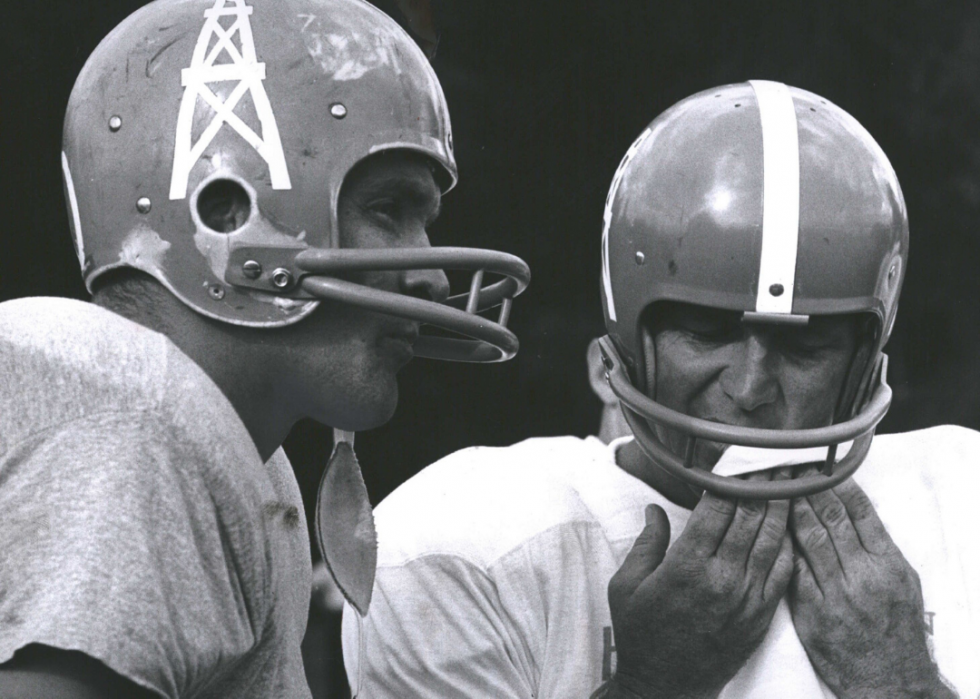
Then: Tennessee Titans
The Houston Oilers (now the Titans) were one of the first teams to wear light blue as a primary color on their jerseys. Although the road-white jerseys had red numbers, red stripes wouldn’t be added to the blue jerseys until 1966.
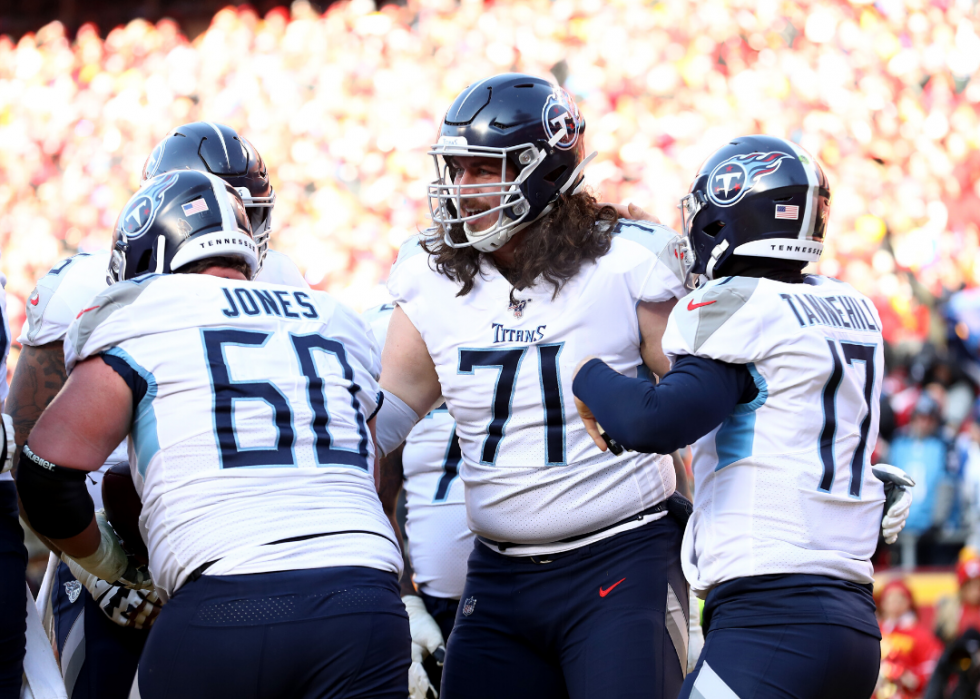
Now: Tennessee Titans
The Titans have one of the most detailed jerseys in the NFL. The numbers apparently all point right to indicate the northeastern section of Tennessee. The triangular shoulder design evokes a sword, which has long been a team symbol.
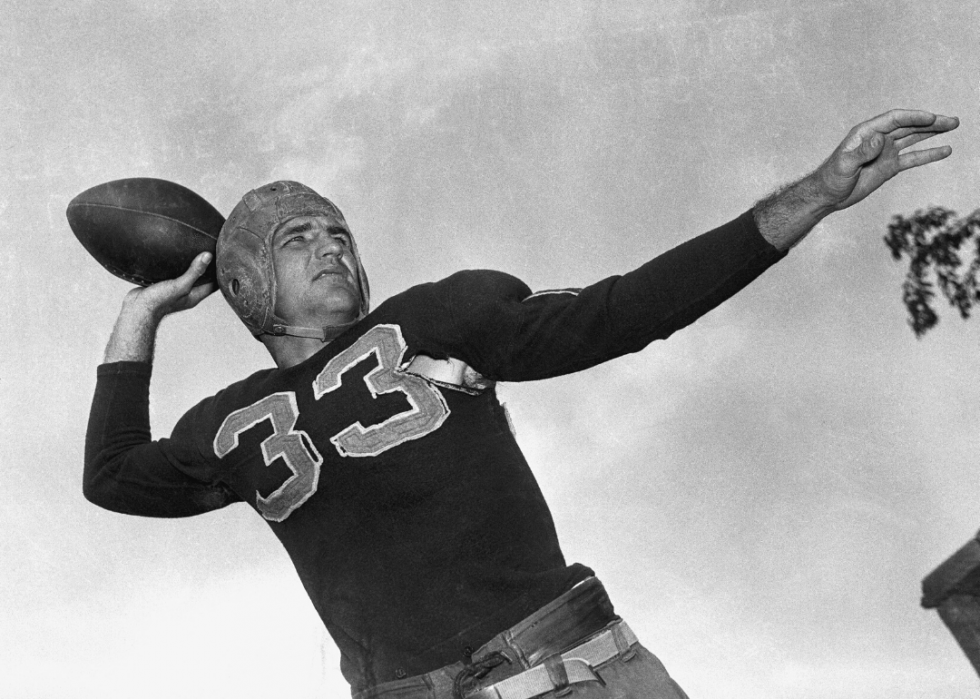
Then: The Washington Football Team
Sammy Baugh was a rugged player throughout a Hall of Fame career, although we’re pretty sure that rips in the sleeves were not standard on every Washington football jersey during his playing days. The use of outlined numbers is somewhat rare, and the team occasionally wore navy jerseys, which are no longer a primary color for Washington.
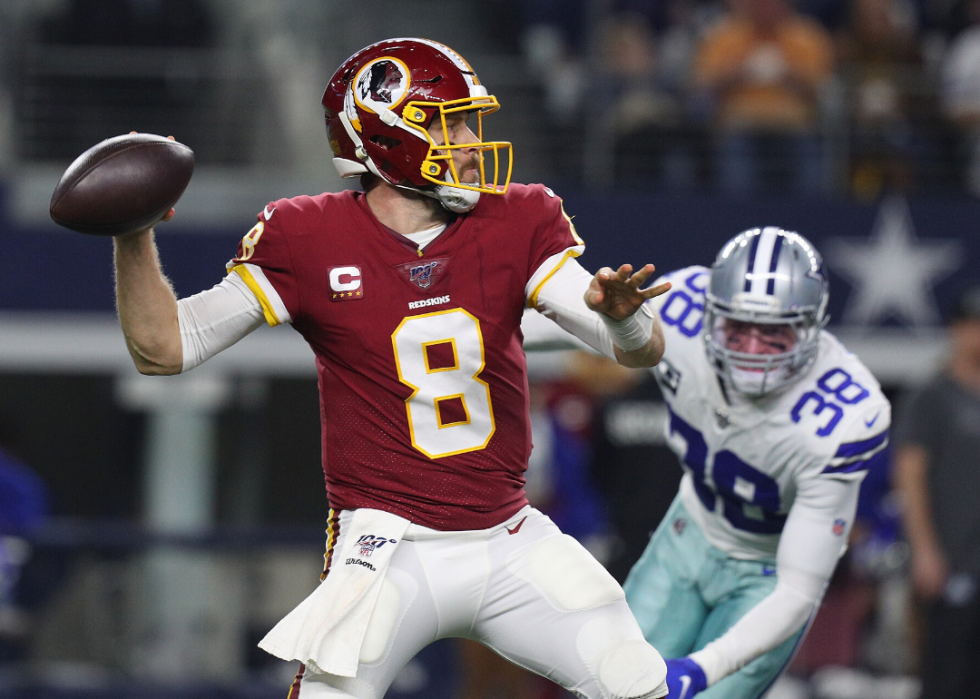
Now: The Washington Football Team
Washington's jerseys haven't changed much over the past 50 years. Older versions had more prominent stripes, but a reliance on burgundy and gold has always been a staple. The team's name change came with a jersey change that replaced the offensive logo with the player's number.



